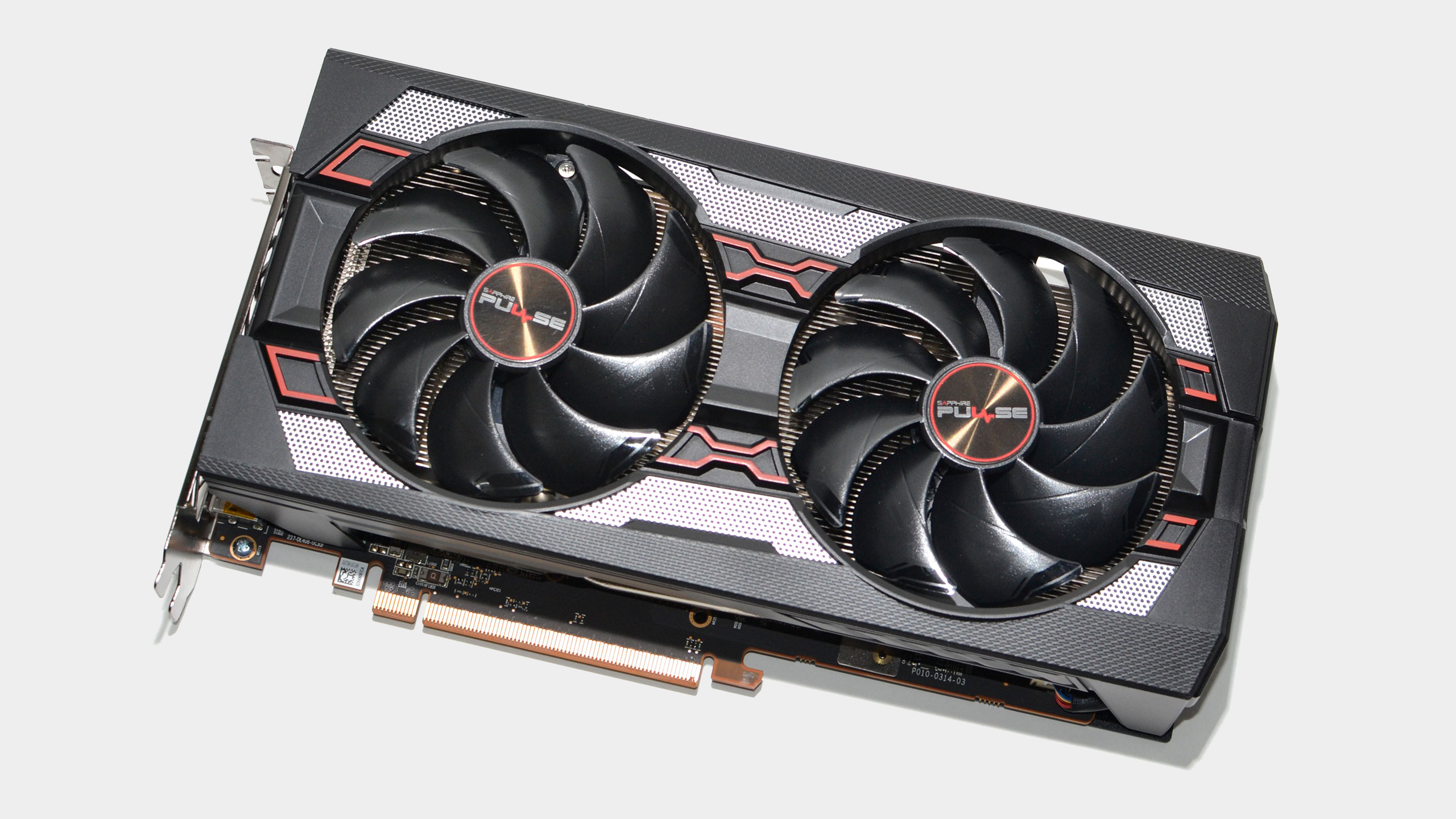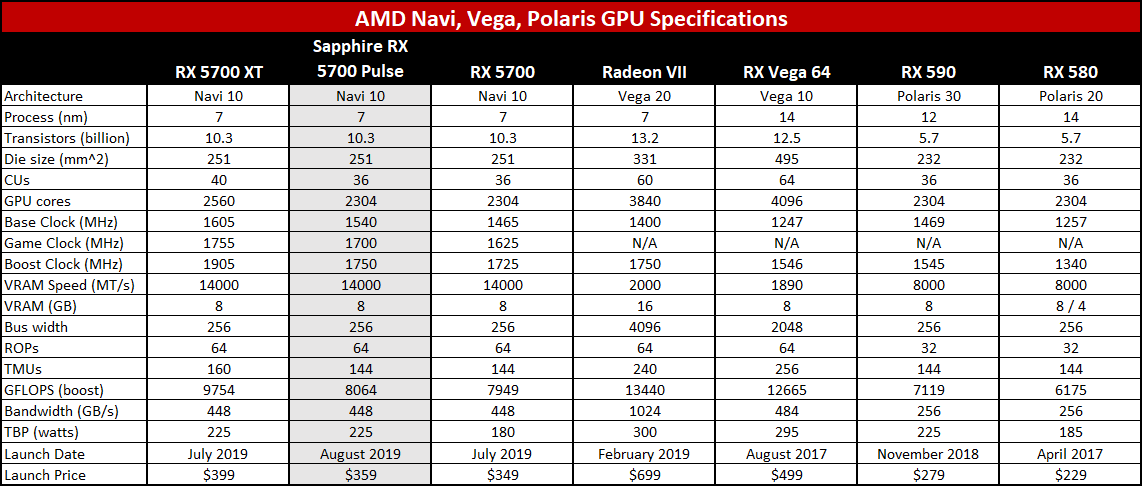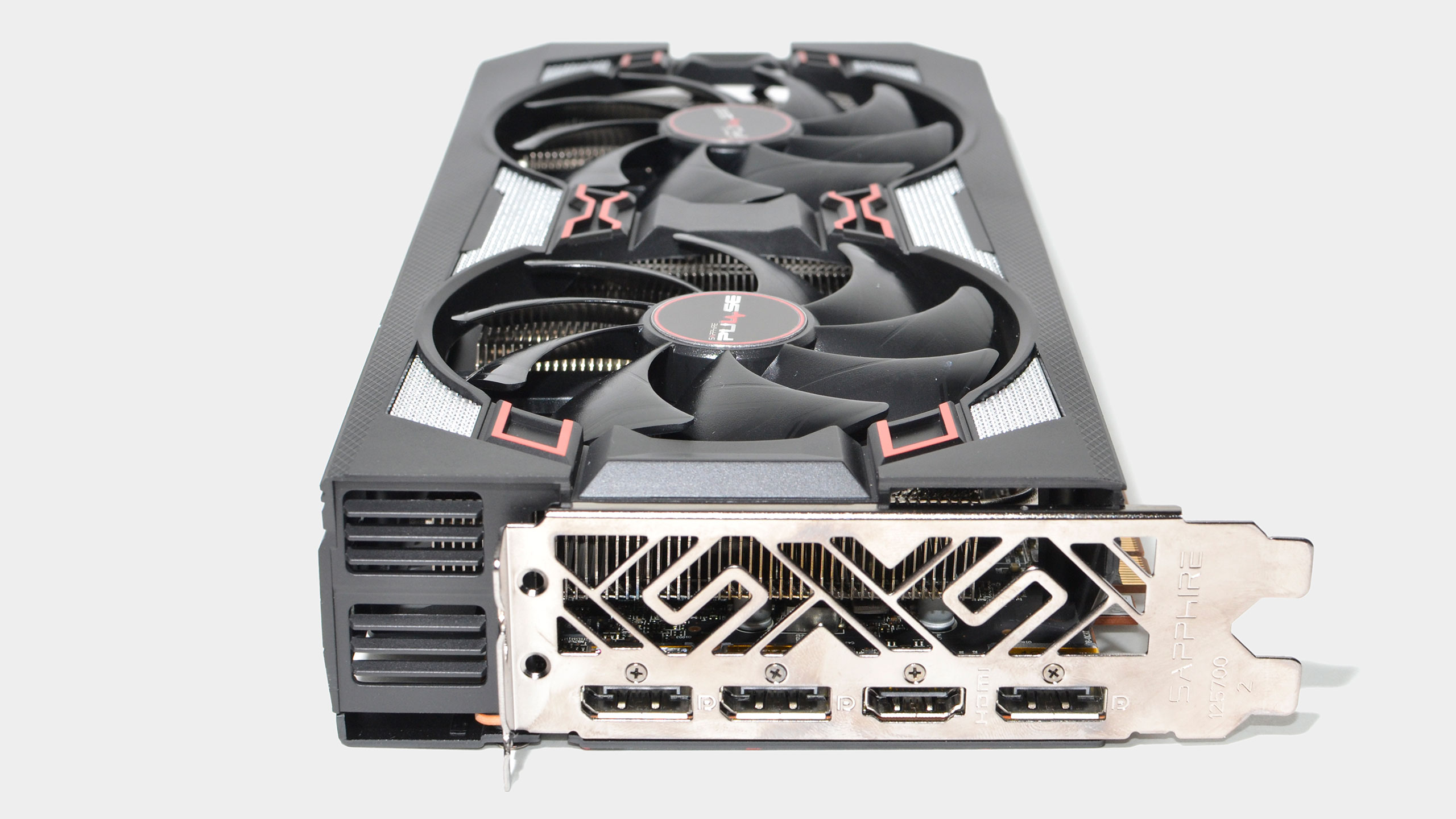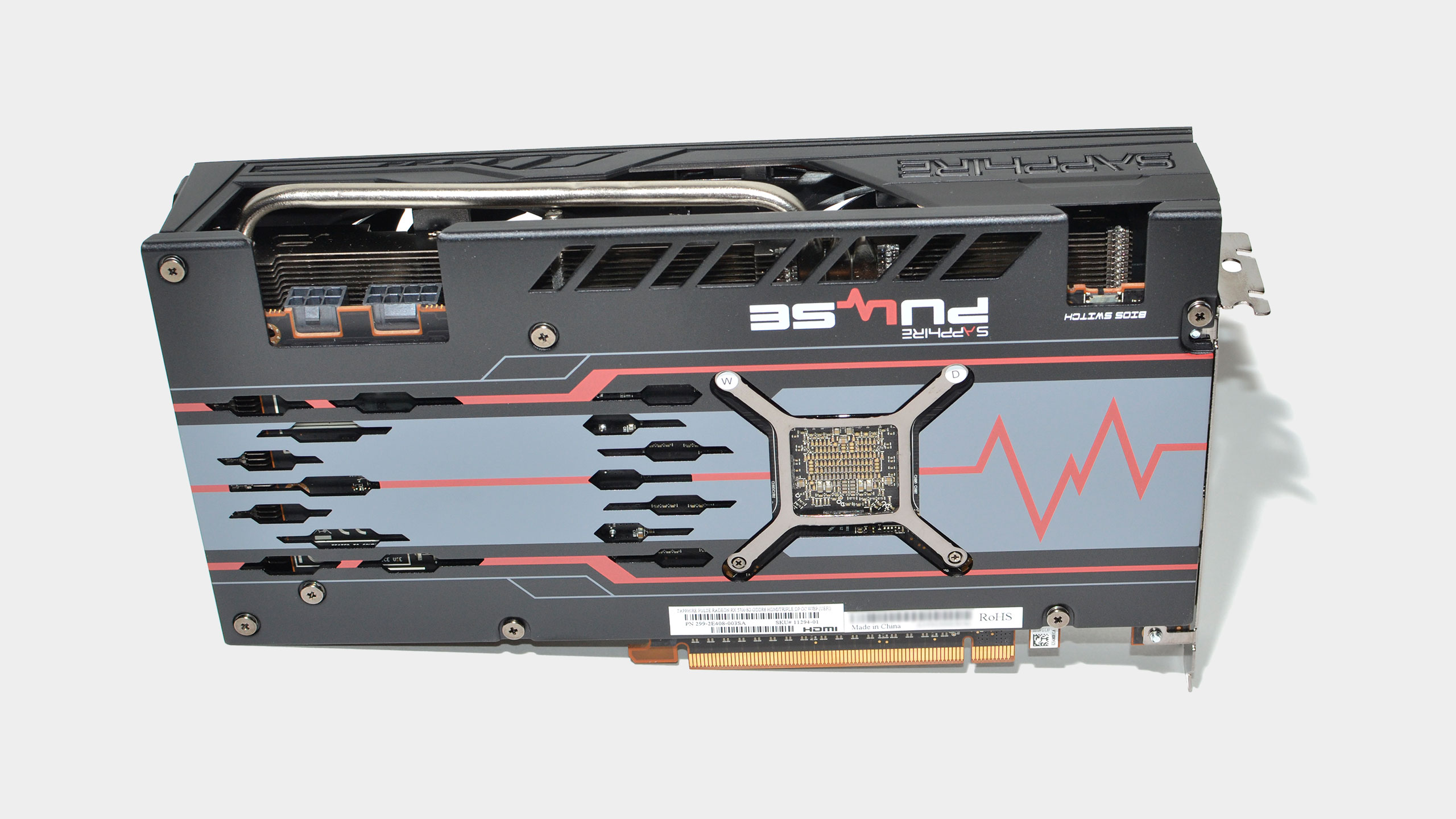Our Verdict
Sapphire's RX 5700 Pulse runs cooler and quieter than AMD's reference design, delivering good performance in a better package.
For
- Fast and efficient
- Cool and quiet
- Good value
Against
- No DXR support
- Lower perf/W than RTX 2060
PC Gamer's got your back
AMD came out with a huge selection of new 7nm products in July, including new CPUs and graphics cards, drowning hardware enthusiasts with new choices. I had some concerns with the GPUs, though. The blower fans on the reference RX 5700 and 5700 XT aren't exactly quiet, and the earliest drivers for the Navi architecture seemed to have a few hiccups. A couple of months later, with a custom card courtesy of Sapphire in hand, I now have the RX 5700 that I really wanted. The Sapphire RX 5700 Pulse is everything good about Navi, with slightly boosted clocks and a better overall design. If you've wanted an RX 5700 but were waiting for a non-blower cooling solution, look no further.
To be fair to AMD, this was almost certainly the plan from the beginning: release the reference designs to reviewers and board partners, who would sell them to early adopters for the initial launch; then phase out the reference cards once custom partner cards are readily available. There are other reasons to avoid the reference cards, though—like the fact that AMD specs the cards to allow for up to 125C temperatures on the VRMs. You shouldn't normally see such temperatures, and I never did during testing, but with the right workload and in the wrong case, it's possible for the reference designs to get excessively hot. While the reference designs are a good representation of the baseline level of performance you can expect from most GPUs, whether it's AMD or Nvidia cards, I almost always recommend sticking with custom designs.
Fundamentally, nothing has changed. This is the same Navi / RX 5000 architecture, built on the same TSMC 7nm microprocessor manufacturing node. The circuit board might be slightly tweaked (it's covered with a shroud so I don't know if it's the same as the reference board or not), and it has a different cooling solution with dual fans, a large heatsink, and several heatpipes. Sapphire also gooses the GPU clocks a bit. Not much more than you could accomplish via manual overclocking with just about any 5700 card, but it's a factory overclock and fully covered by the warranty.
Here's what AMD's current and previous generation GPUs product stack looks like, with the Sapphire RX 5700 Pulse compared to the reference models.
The big changes are the cooling and clockspeeds. While the Sapphire 5700 Pulse sticks with 14Gbps GDDR6, the GPU's base clock and "Game" boost clock are both 75MHz higher than the reference clocks, and the maximum boost clock is 25MHz higher.
AMD's Game Clock is supposed to be a conservative estimate of the sort of clockspeeds you'll see in actual games, which is theoretically the same idea as Nvidia's Boost Clock. In practice, the Sapphire RX 5700 Pulse basically runs at the Game clock, plus or minus 10MHz, which means it's actually not a conservative estimate. You get what the specs advertise, but Nvidia as an example will often list a boost clock of 1710MHz, but then you'll see boost clocks routinely in the 1850MHz range.
The biggest omission with Navi of course remains. There's still no DirectX Raytracing (DXR) support. That's probably because AMD doesn't want to encourage use of the API until it actually has GPUs that can perform well. Nvidia's GTX 1080 Ti, for example, typically runs far worse than even an RTX 2060 with DXR enabled. Granted, the DXR-enabled games we've seen so far often punish even the fastest GPUs if you try to crank the settings up to max, but AMD has already said it will have future Navi parts (Navi 20) that support the DXR. That's because it's not just Nvidia pushing DXR—Microsoft developed the API, and both the future PlayStation and Xbox consoles, using AMD CPUs and GPUs, will support it. Which means, in another year or so, anyone with an RX 5700 series GPU might start to feel a bit left out.
Keep up to date with the most important stories and the best deals, as picked by the PC Gamer team.
Realistically, we're probably still at least one more generation of hardware away from ray tracing being required, and with hundreds of millions of non-ray tracing GPUs already in the hands of consumers, most games will continue to support existing hardware. By the time ray tracing in games really hits its stride—in maybe 3-5 years—we'll all be looking to upgrade our graphics cards. Rather than putting money in Nvidia's pockets and jumping on the RTX bandwagon early, if you need an upper mid-range graphics card right now (or you can call it lower high-end), the RX 5700 has plenty to offer.
My standard GPU testbed from about two years ago continues to serve me well. It includes a Core i7-8700K overclocked to 5.0GHz to ensure the CPU isn't a bottleneck in testing. In a few instances an i7-9700K or i9-9900K might be fractionally faster in games, but typically the difference is less than a few percent—even less at 1440p and 4K. The PC also uses fast DDR4-3200 CL14 G.Skill memory and SSD storage to ensure the GPU is the limiting factor in performance (as much as possible).
I've updated to the latest AMD 19.9.3 graphics drivers for this round of testing, plus swapped out one game (Shadows of War) for a newer release (Borderlands 3). Yeah, I know we didn't give it a glowing review, but I suspect a ton of people are still going to play Borderlands 3 and it's far more relevant in today's market than the two-years-old Shadow of War. (Besides which, Shadow of War continues to have massive stuttering issues with AMD's newer drivers at higher quality settings.)
Sapphire RX 5700 Pulse gaming performance
As before, I've got 11 games that include a pretty even mix of AMD and Nvidia promoted titles, arguably slanted even more in Nvidia's favor now. DirectX 12 is utilized in most cases, though Borderlands 3 still needs some help before I switch to DX12, and the "DX12 Beta" support in Total War: Warhammer 2 performance is also weak on Nvidia GPUs, so I've tested BL3 in DX11 mode, and TWW2 in DX11 on Nvidia GPUs. Each card is tested at four settings: 1080p medium (or equivalent) and 1080p/1440p/4k ultra (unless otherwise noted). Every setting is tested multiple times to ensure the consistency of the results, and I use the best score. Minimum FPS is calculated by summing all frametimes above the 97 percentile and dividing by the number of frames, so that it gives a reasonable representation of the lower end of the performance scale, rather than looking only at the single worst framerate from a benchmark run.
Here are the gaming performance results for Sapphire's RX 5700 Pulse.
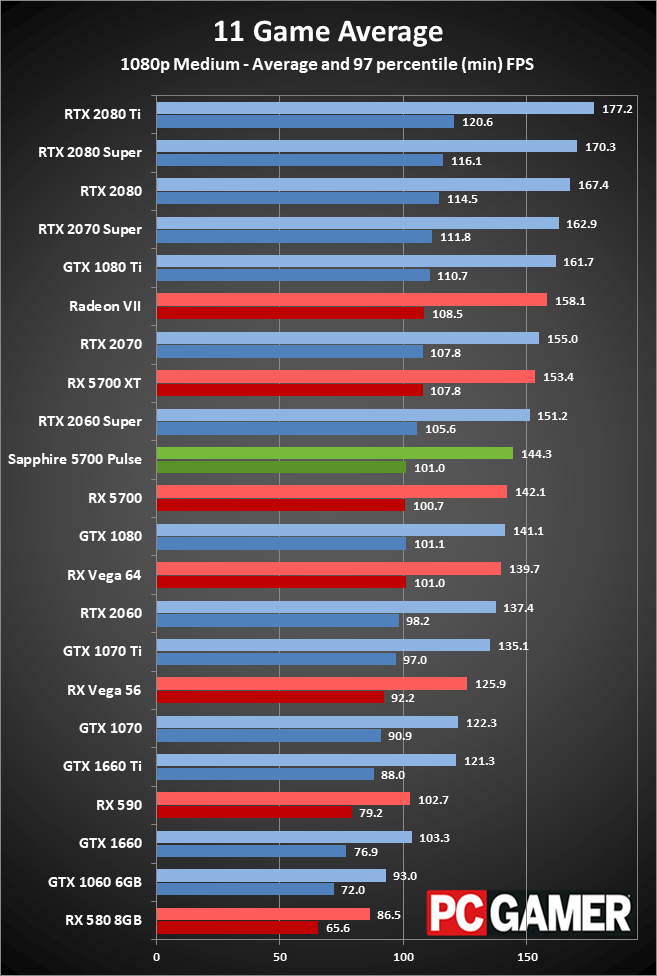
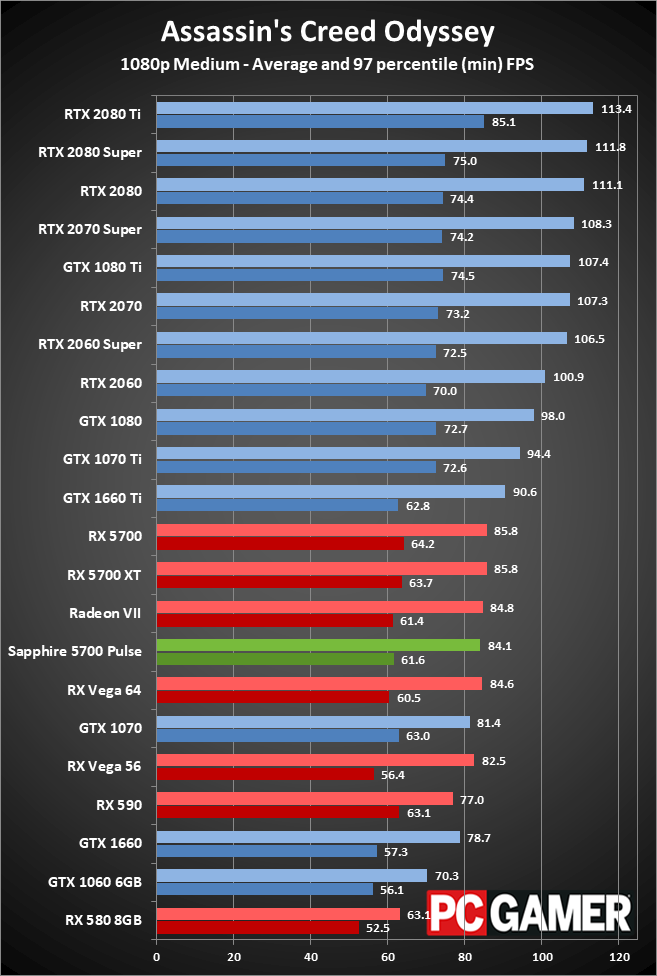
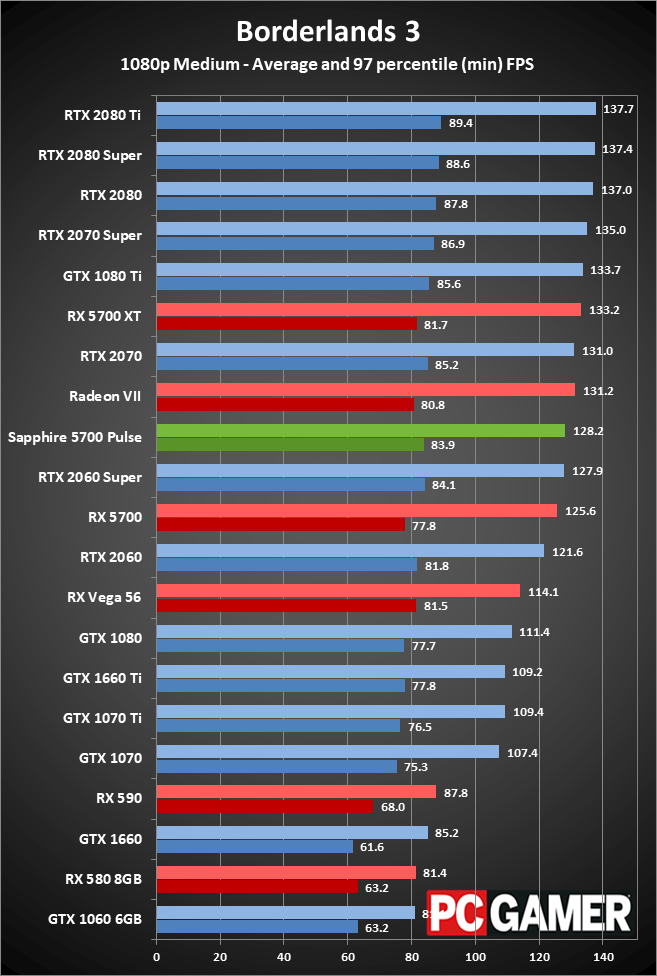
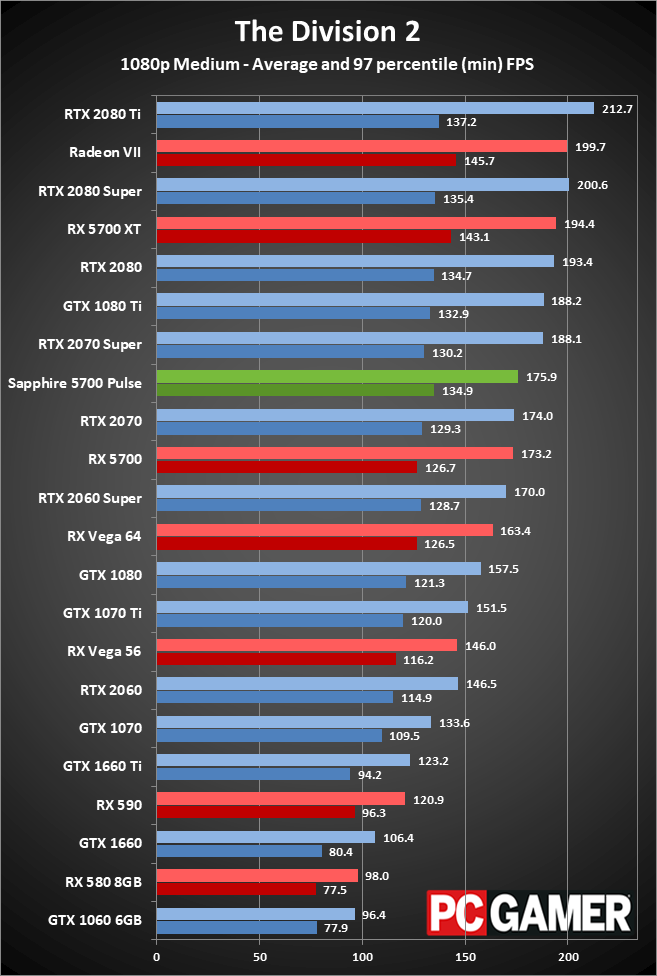
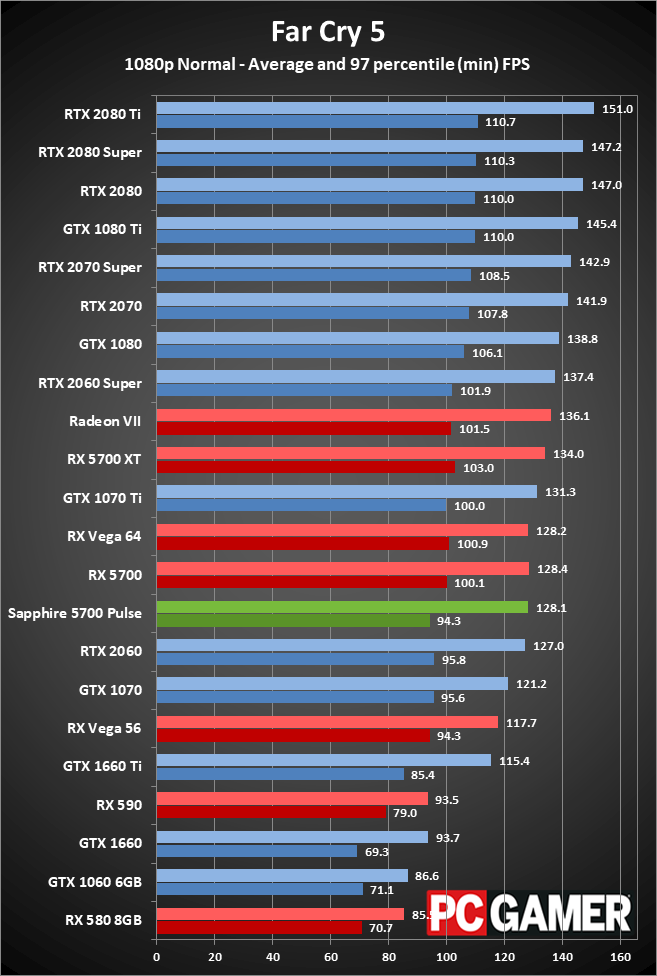
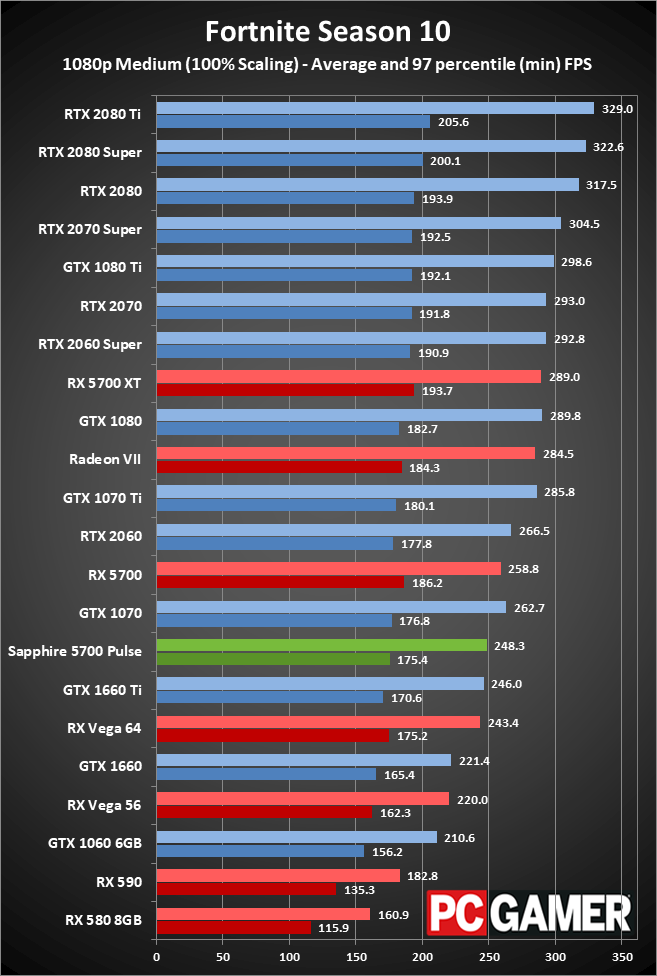

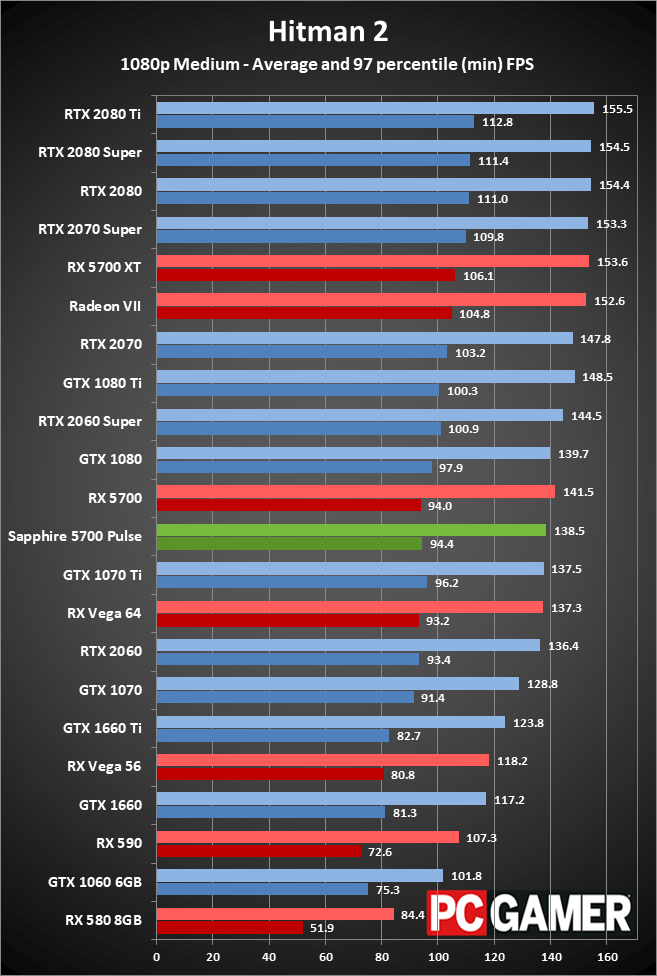
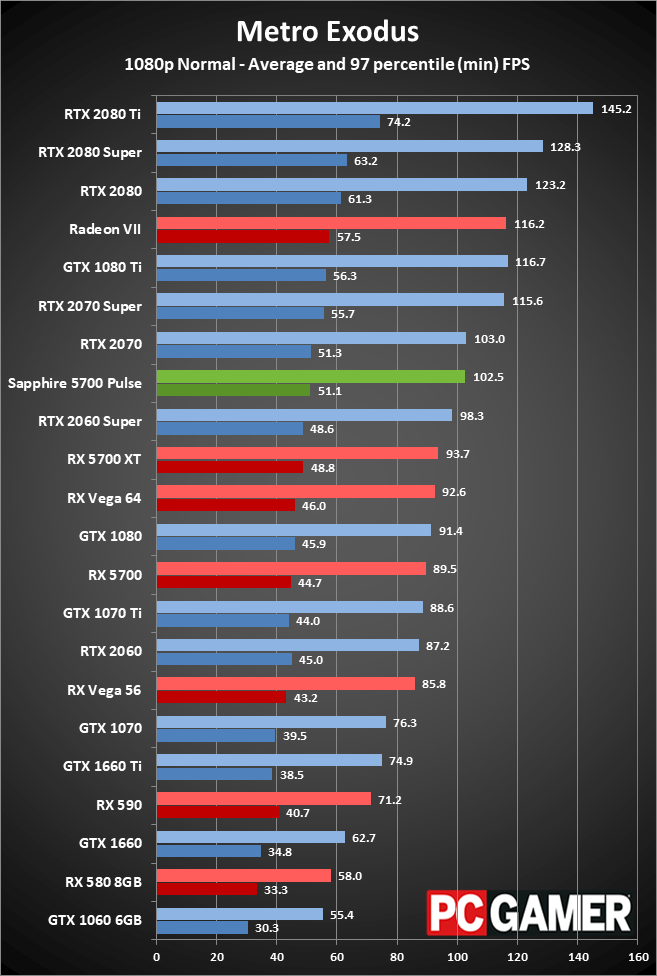
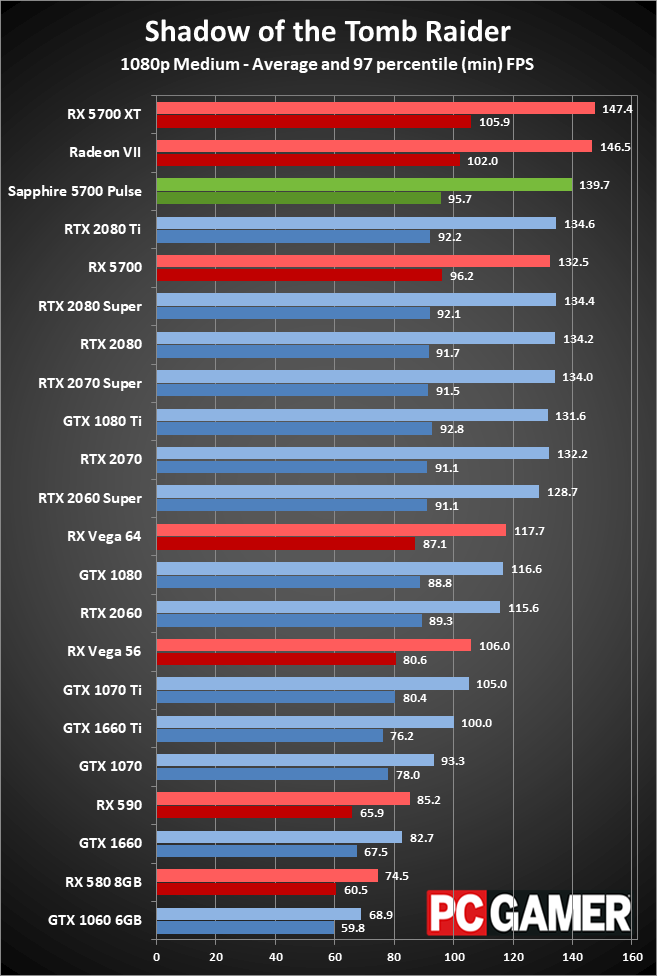
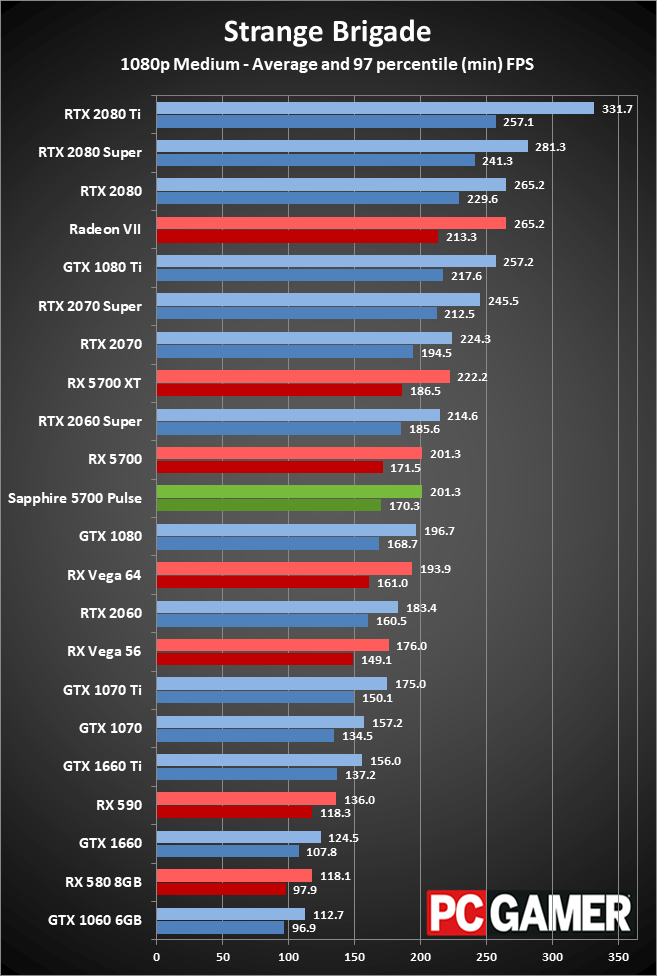
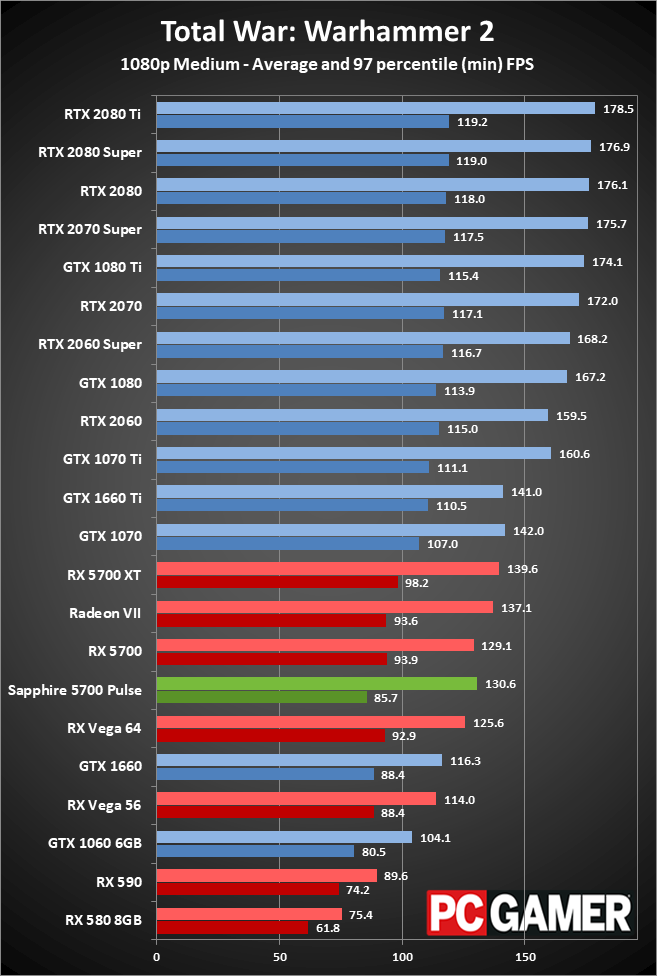
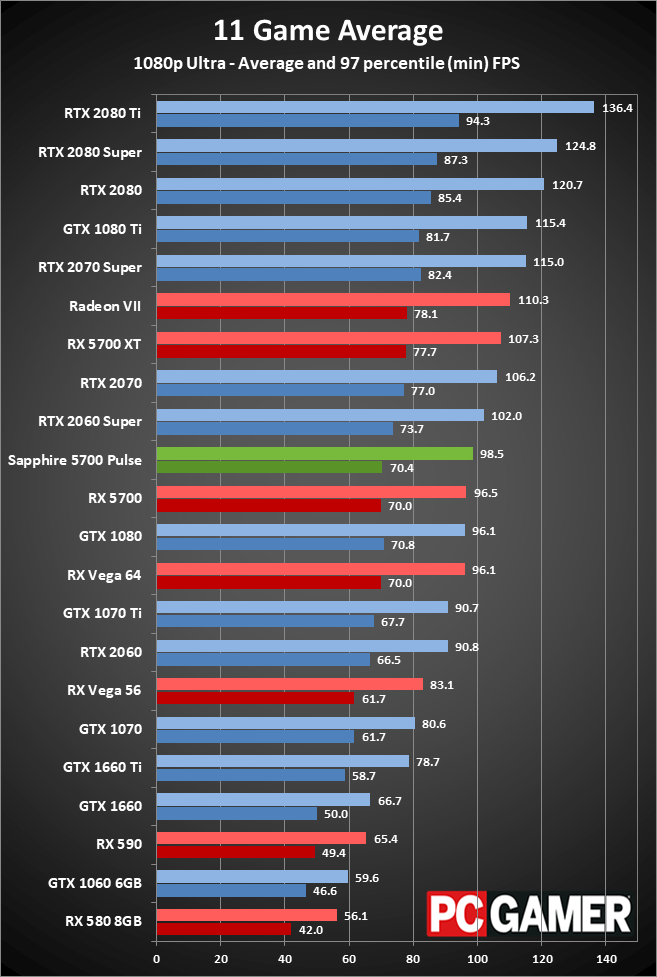
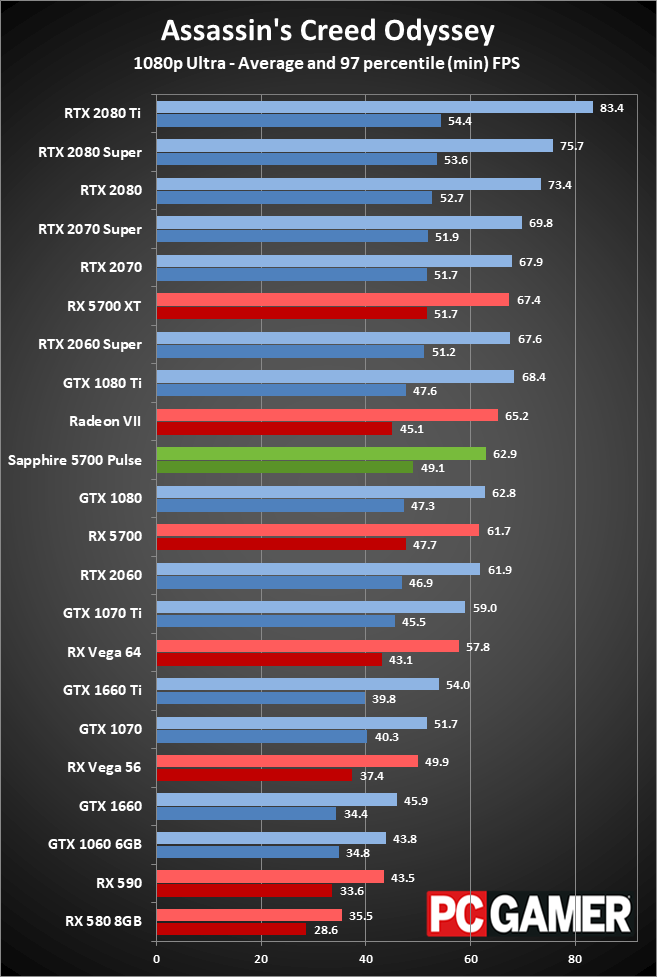
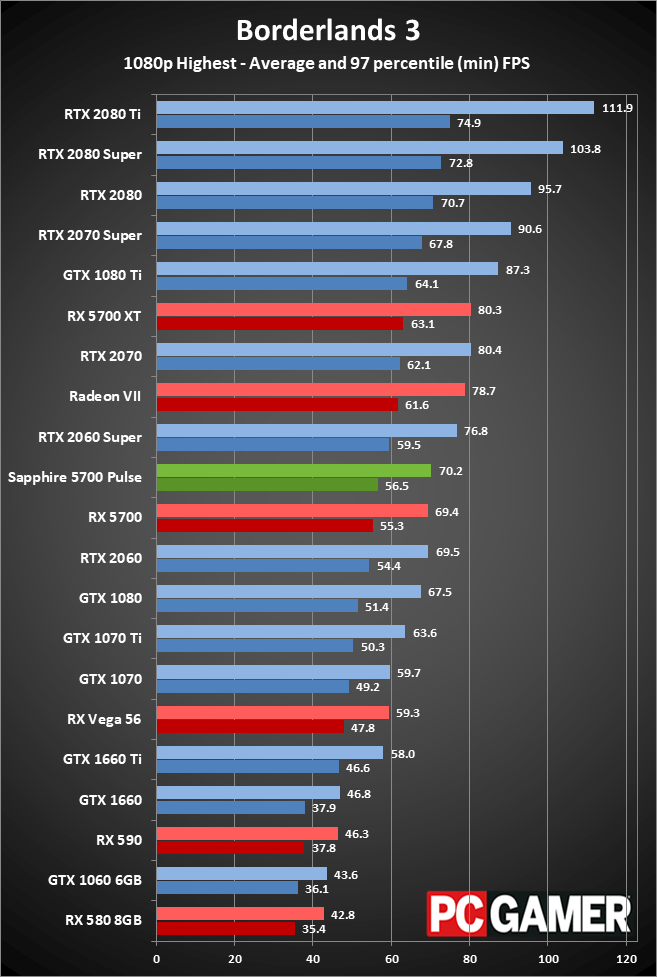
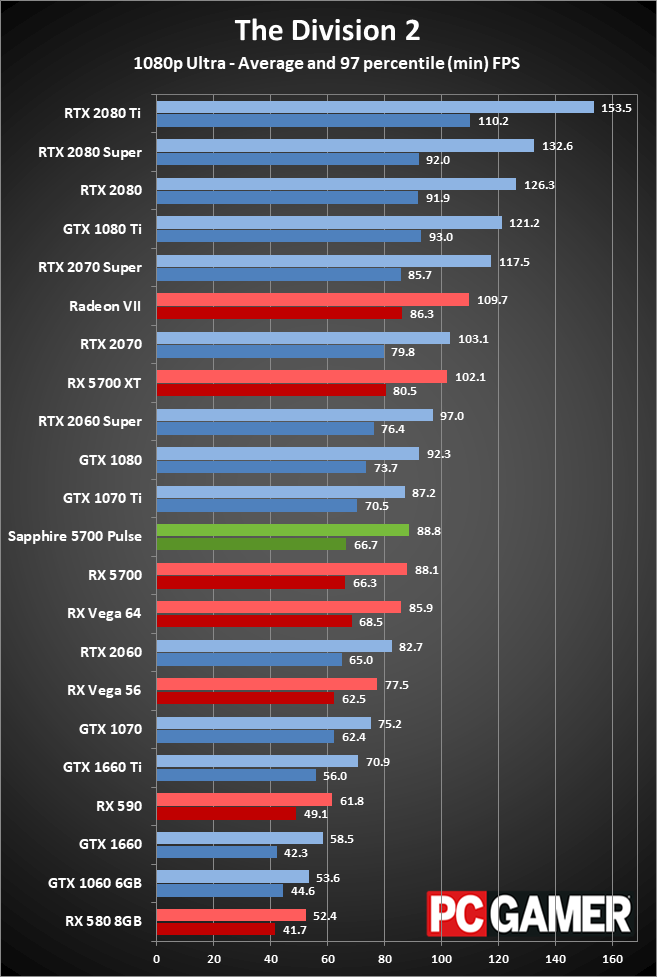
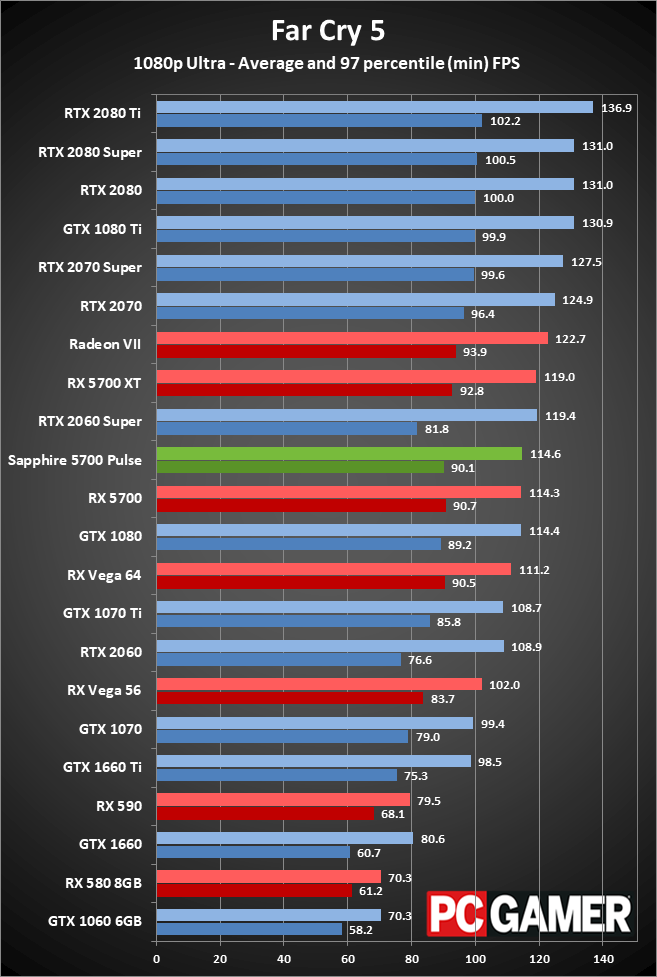
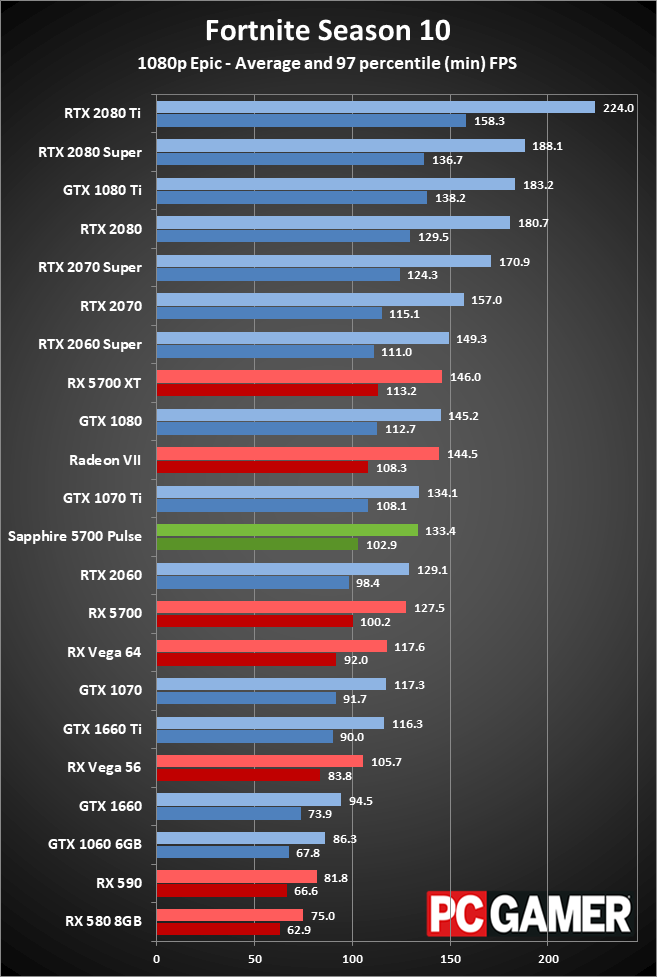
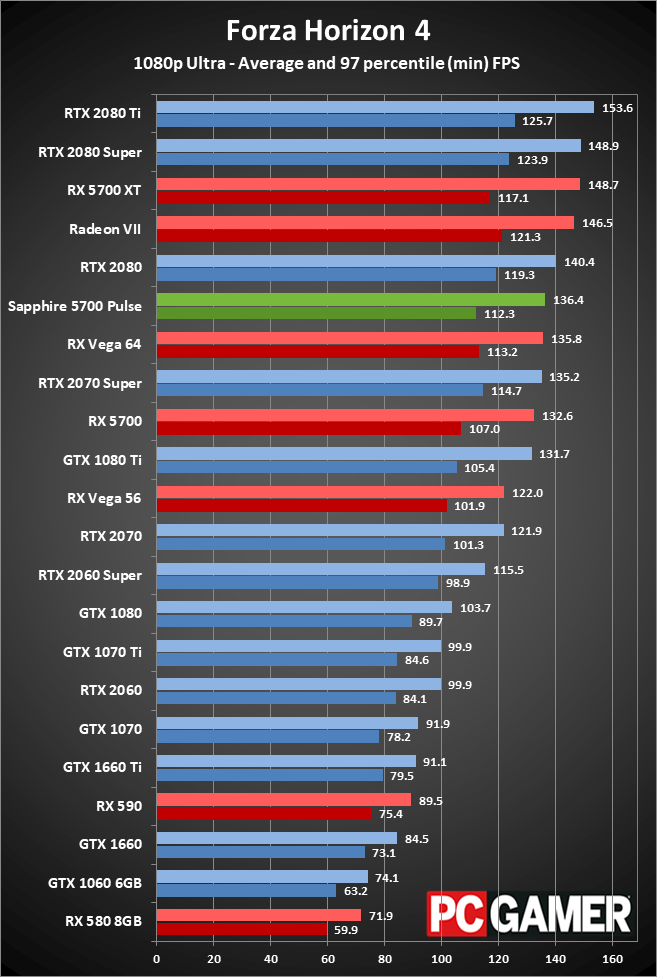
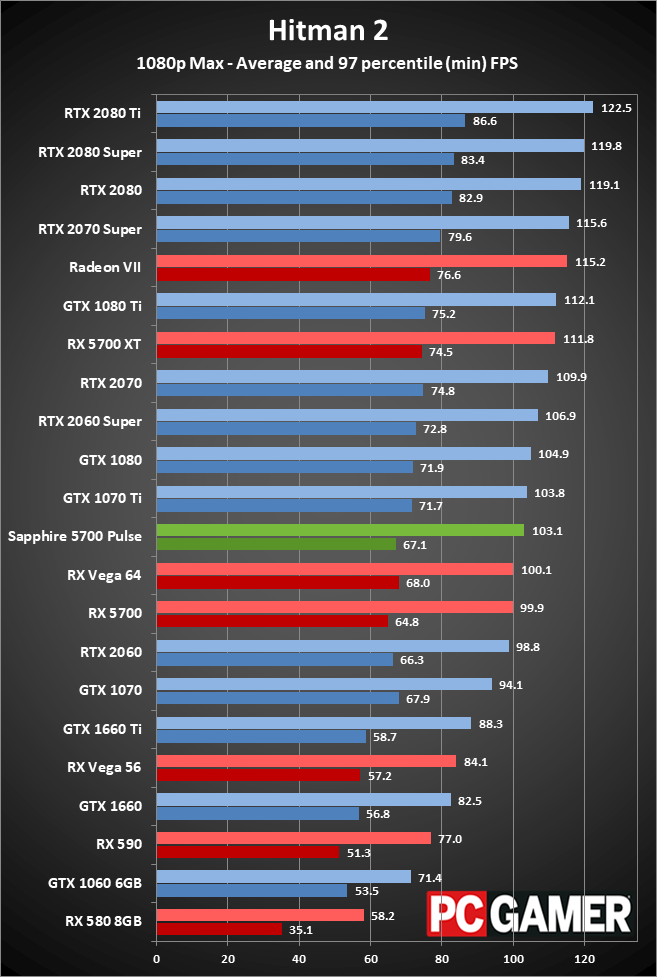
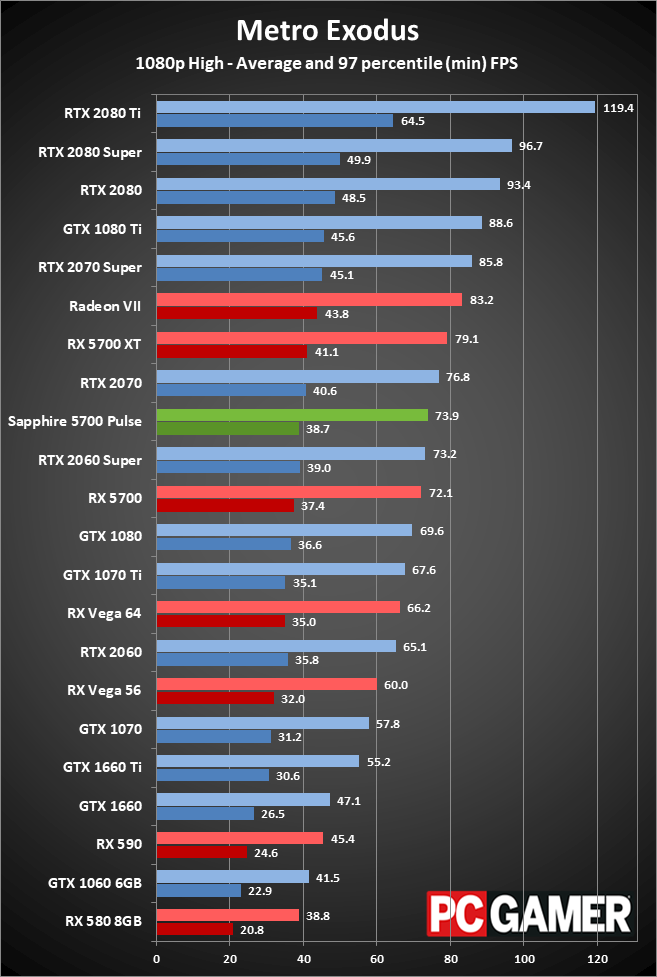
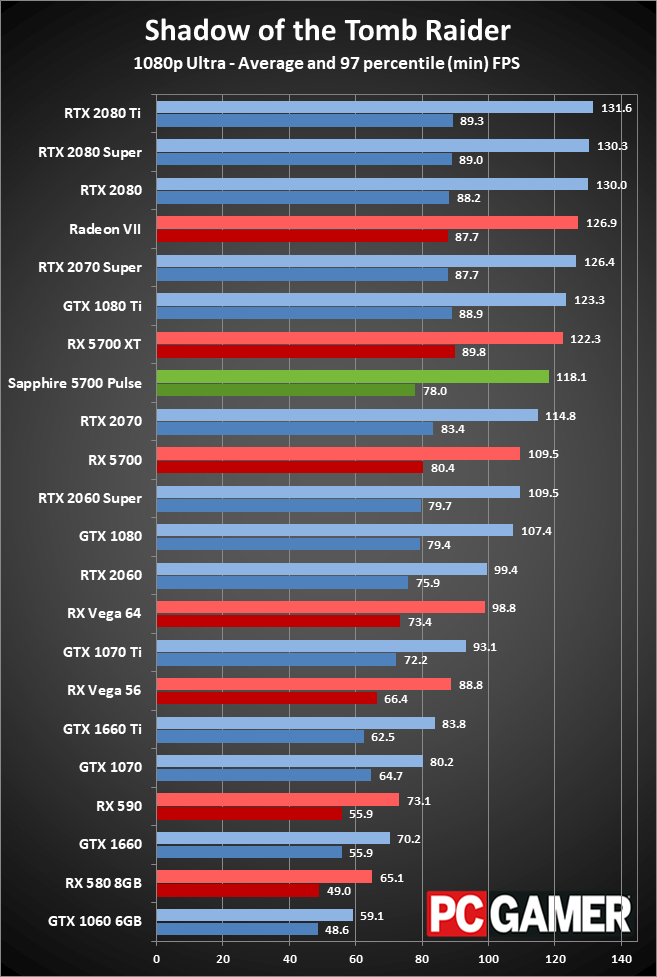
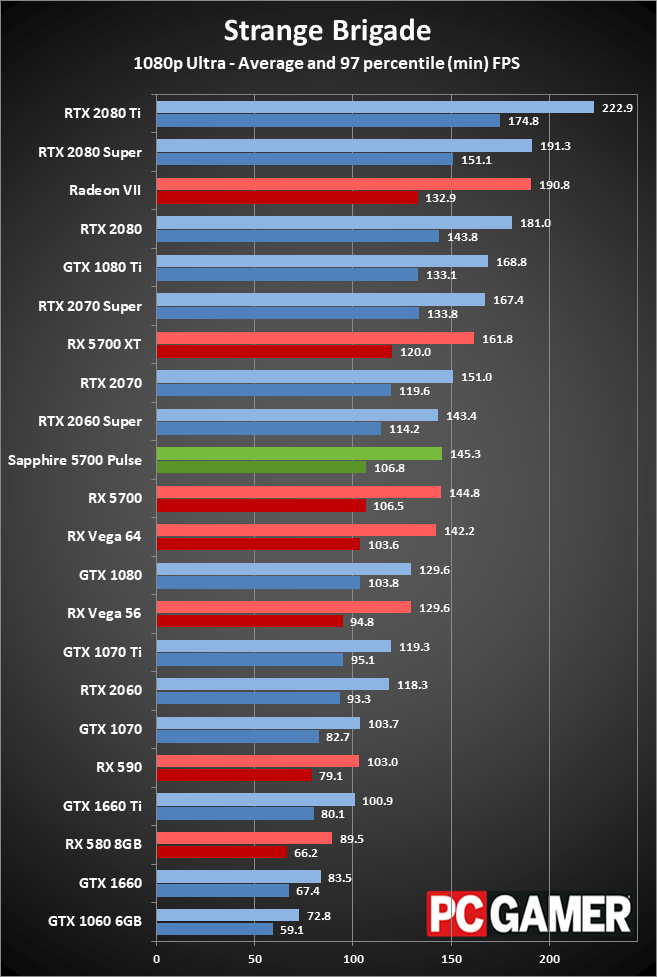
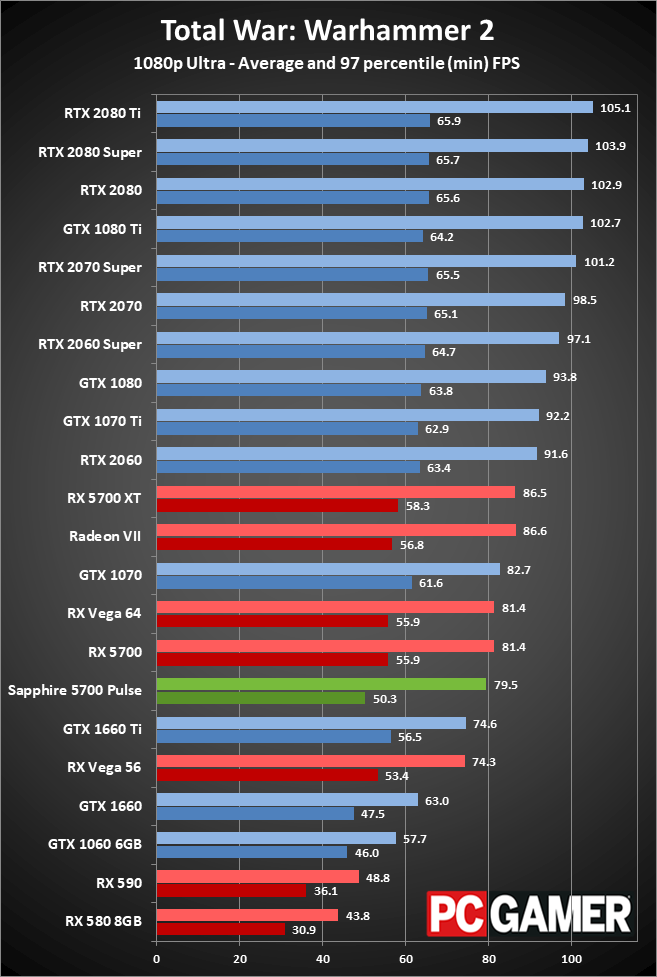
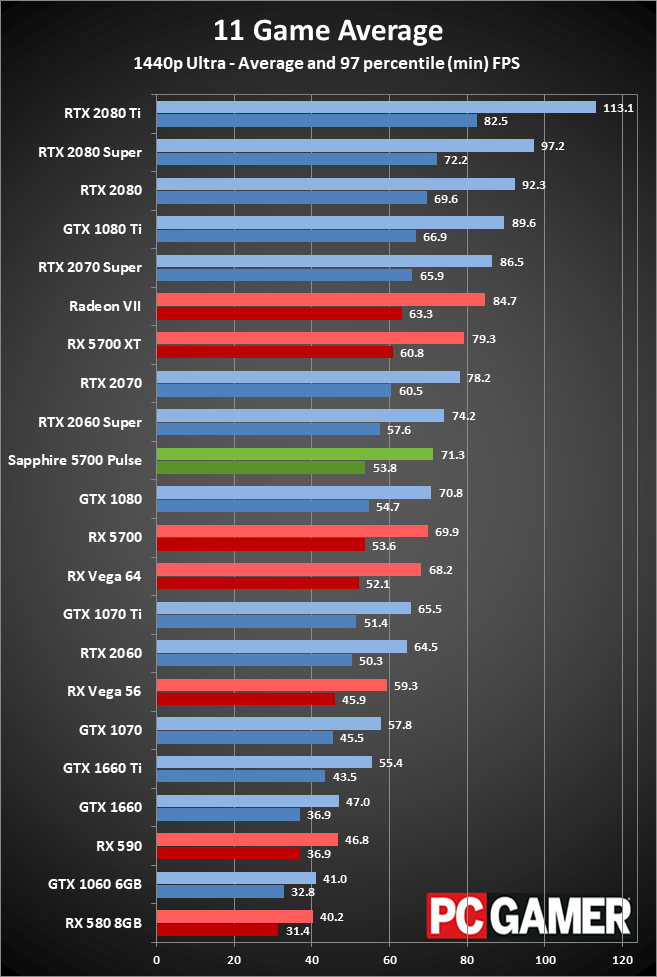
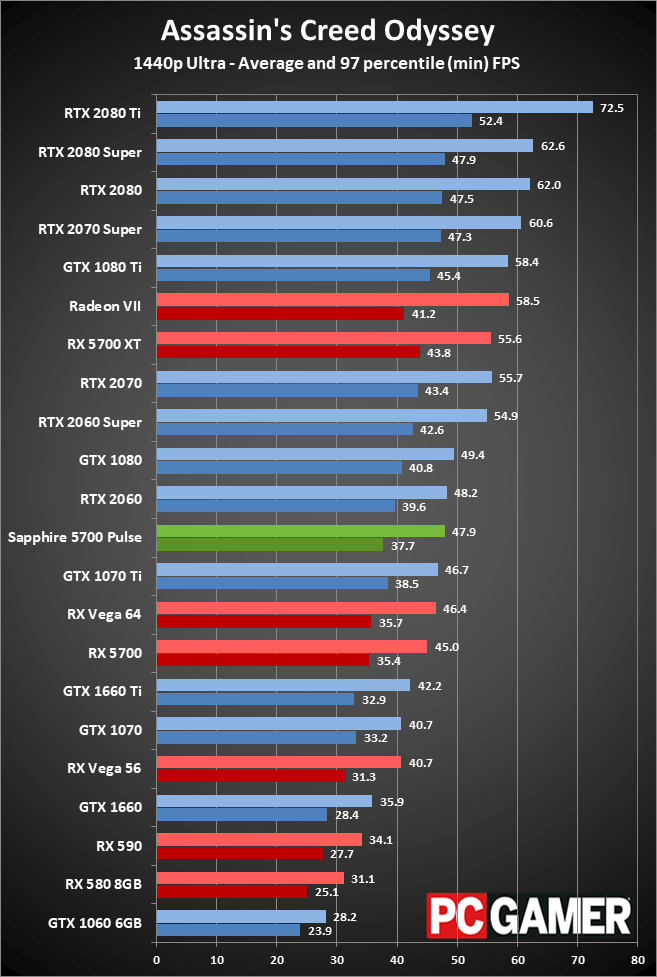
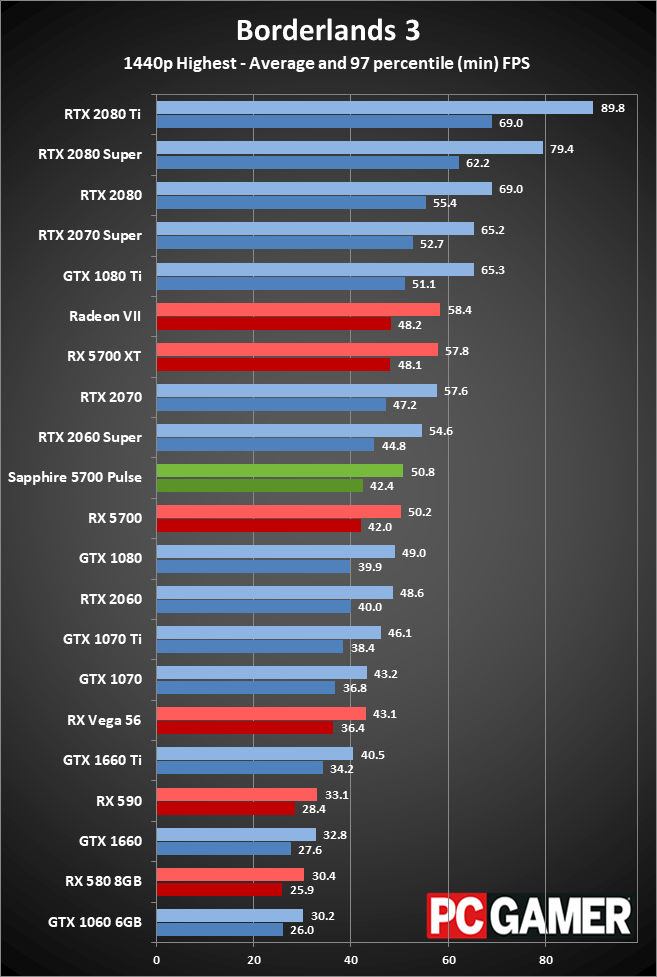
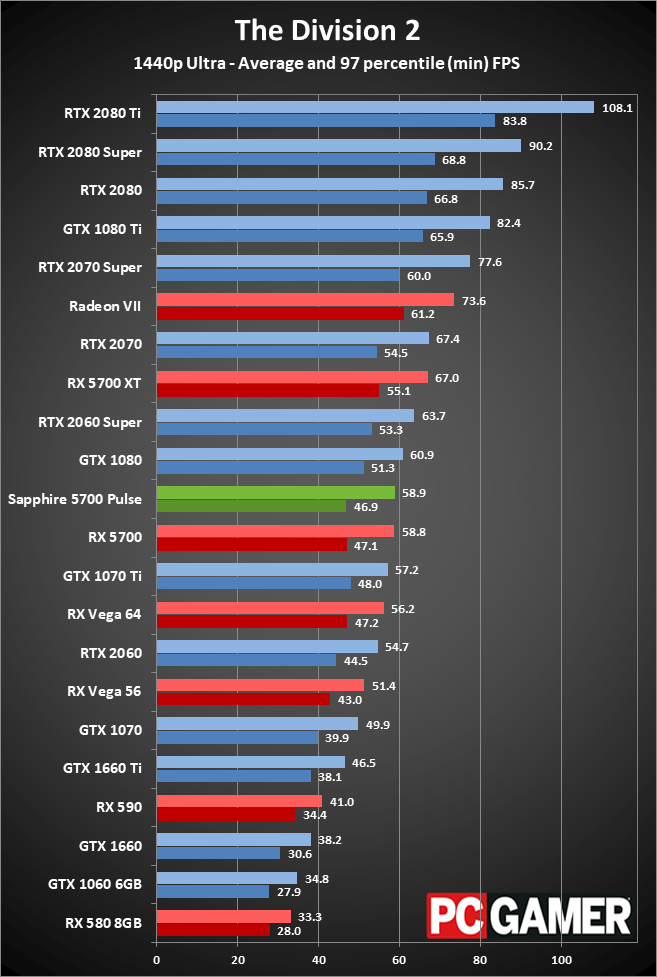
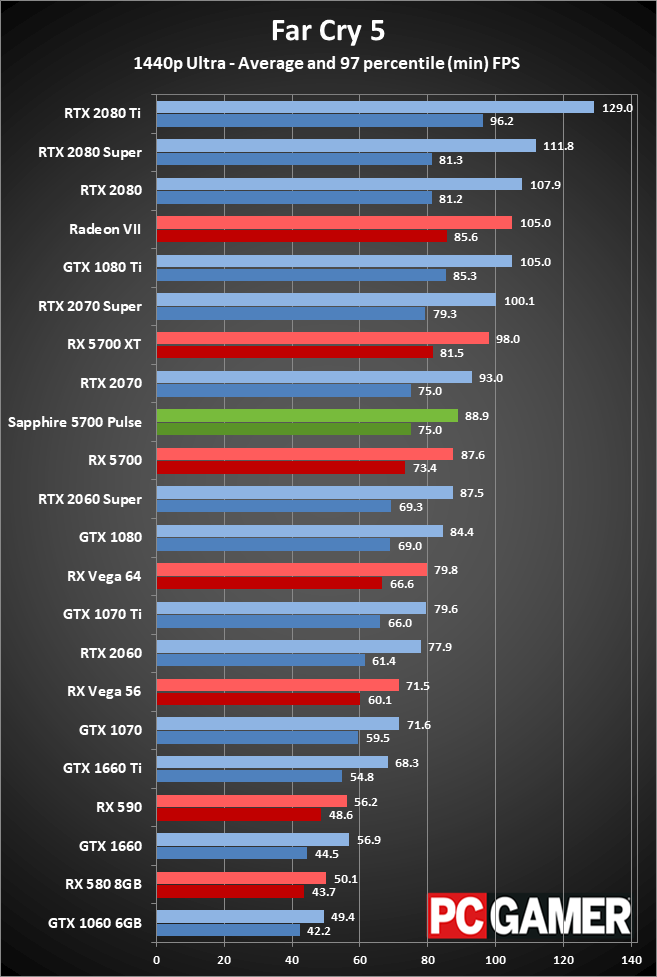
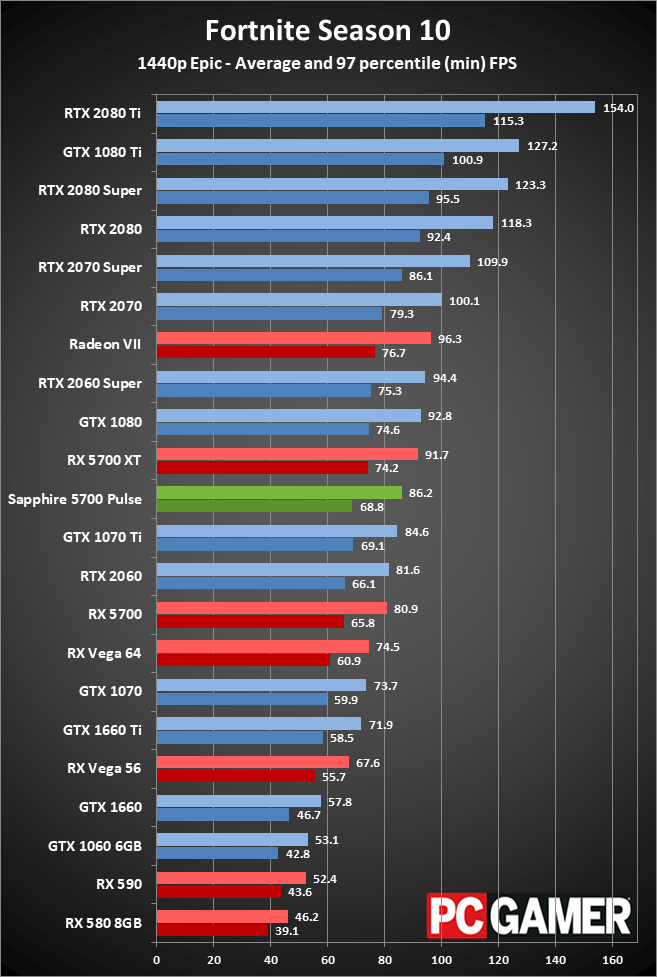
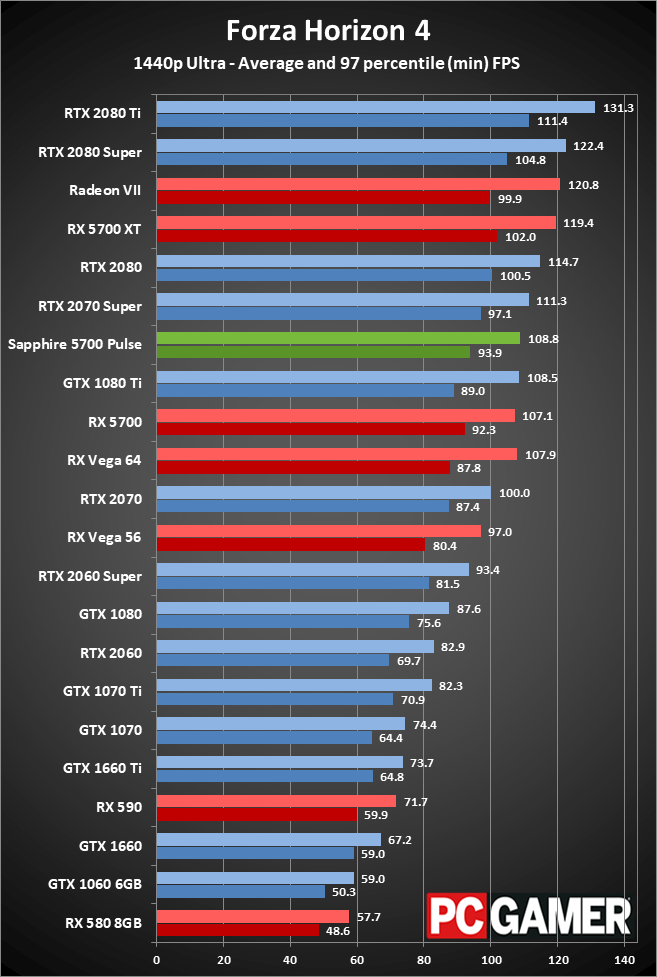
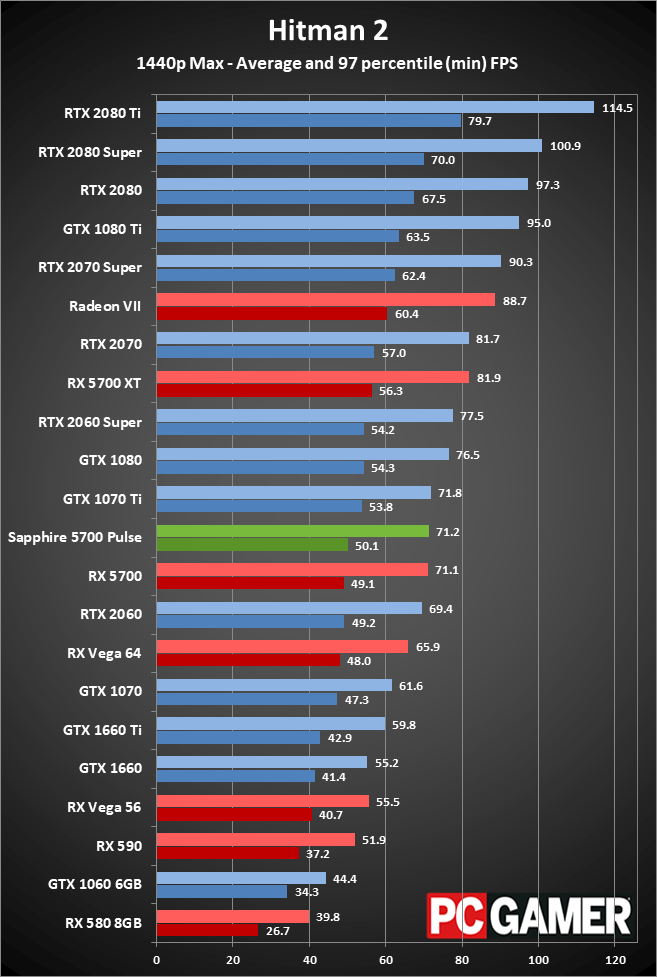
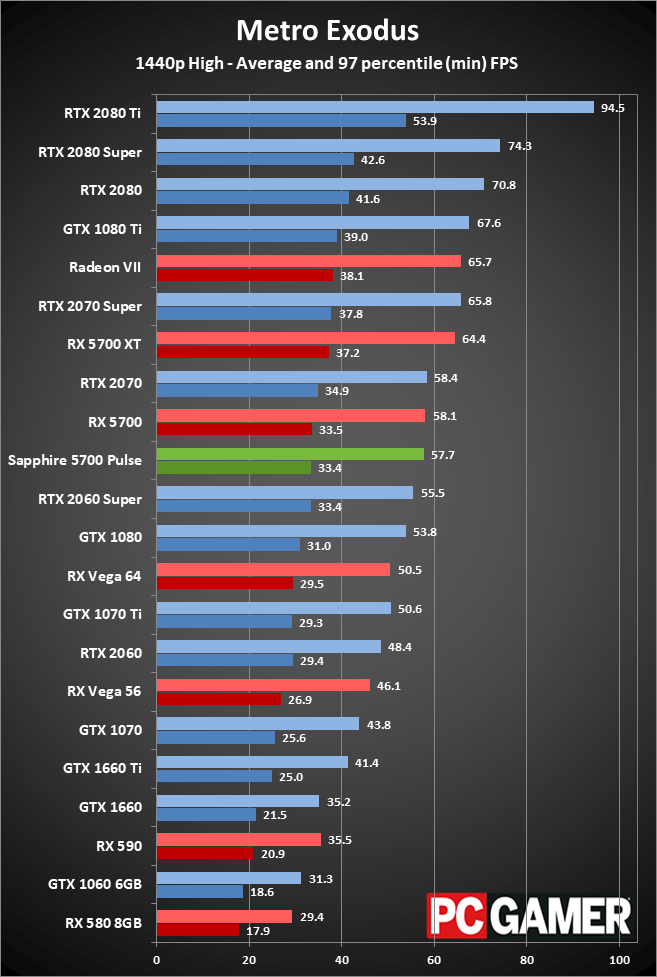
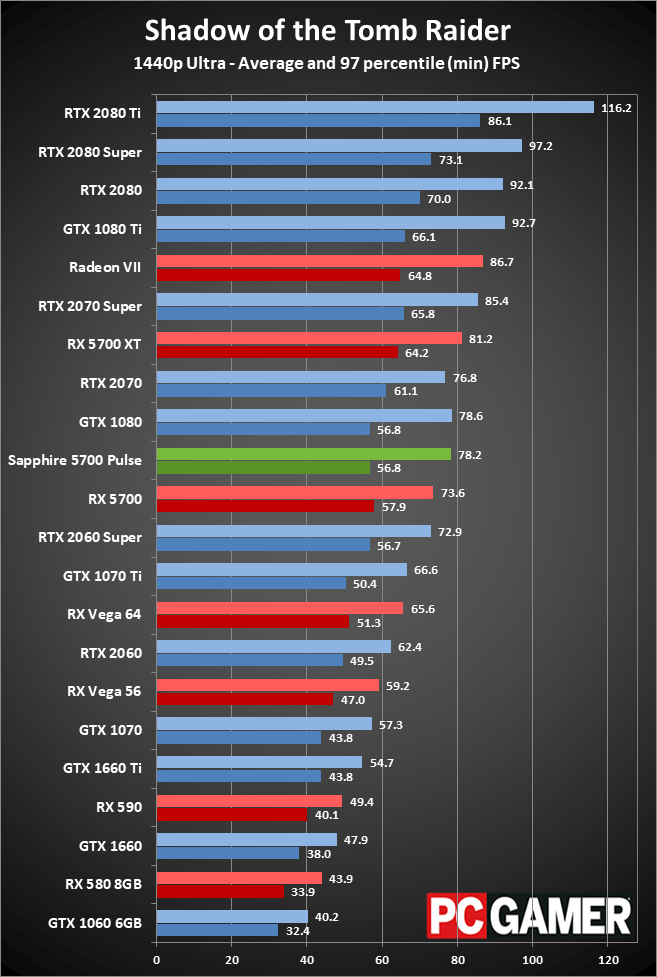
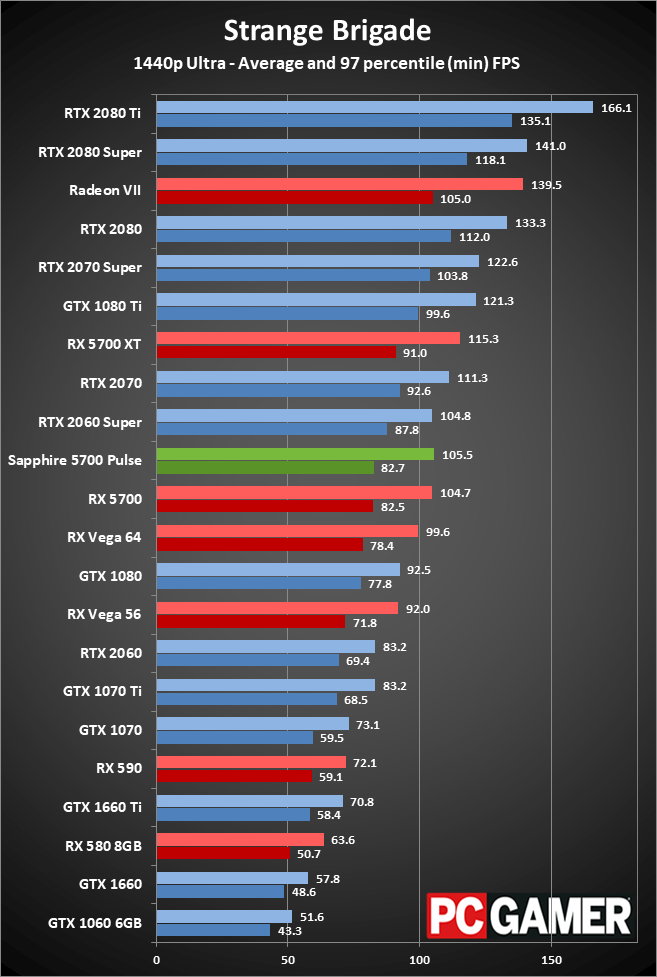
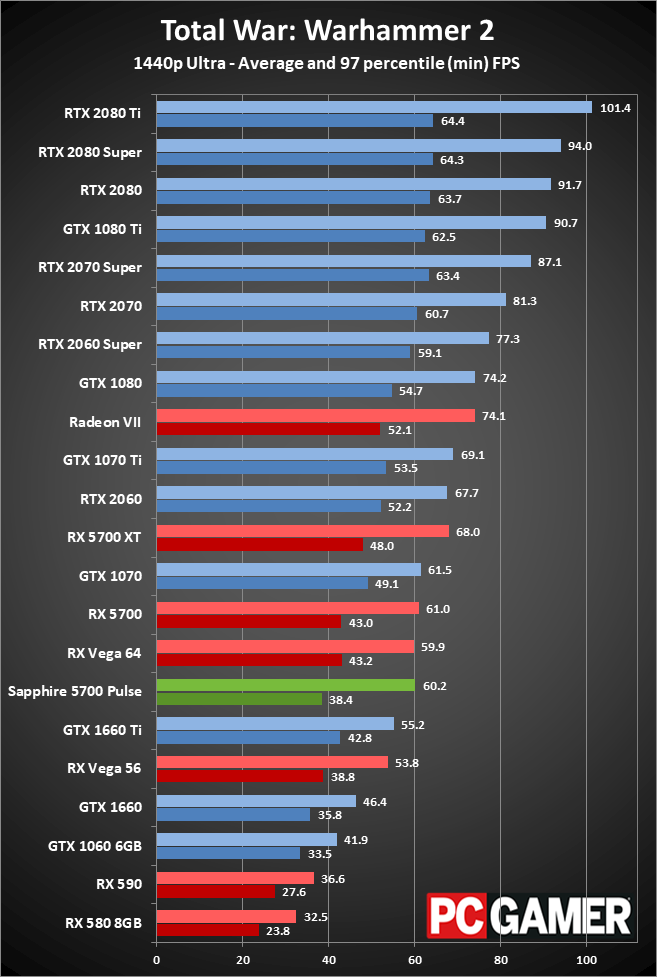
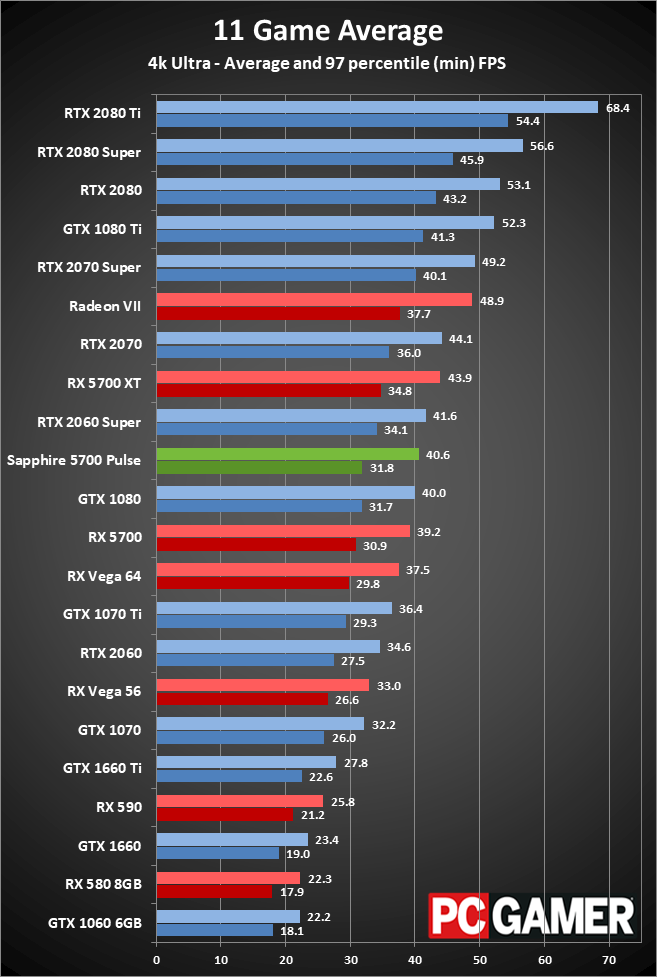
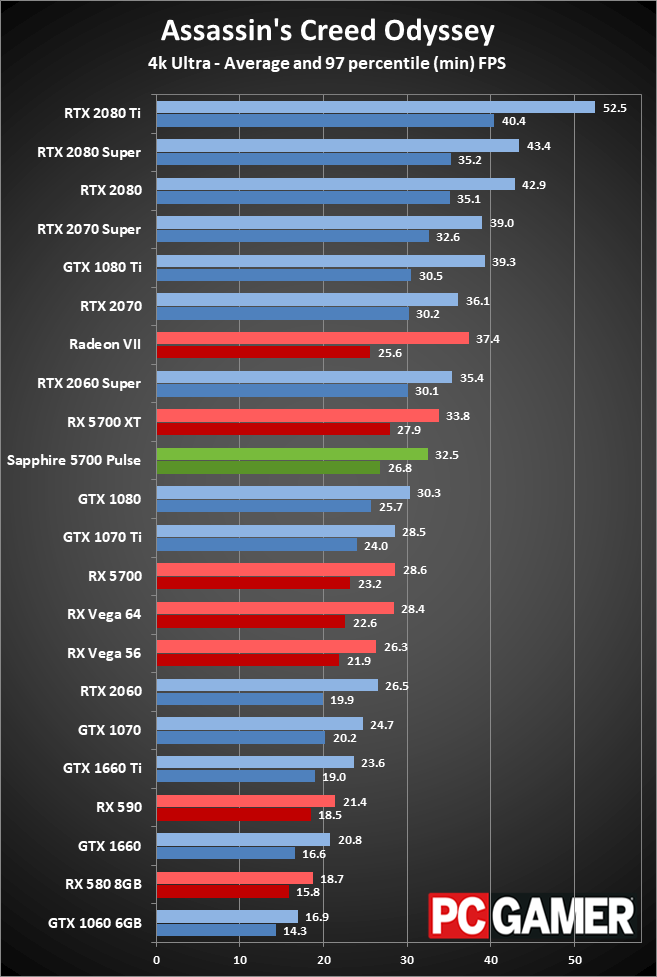
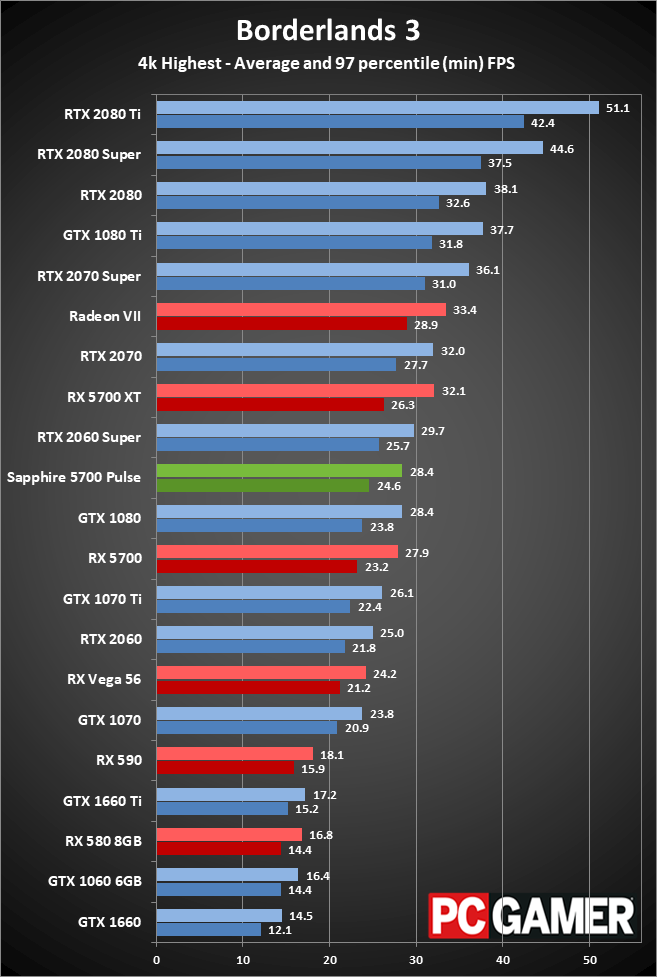
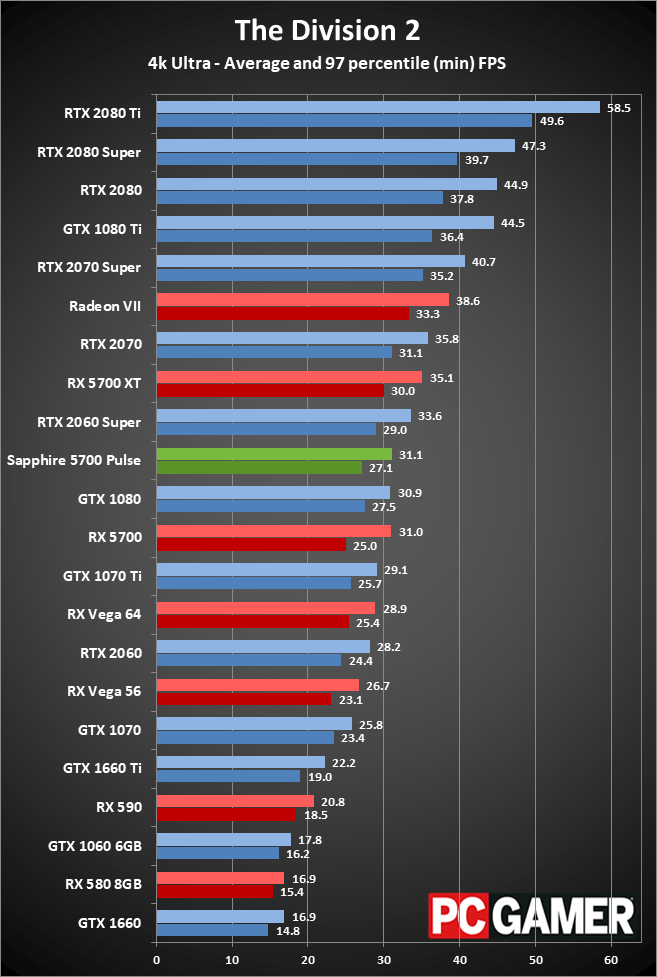
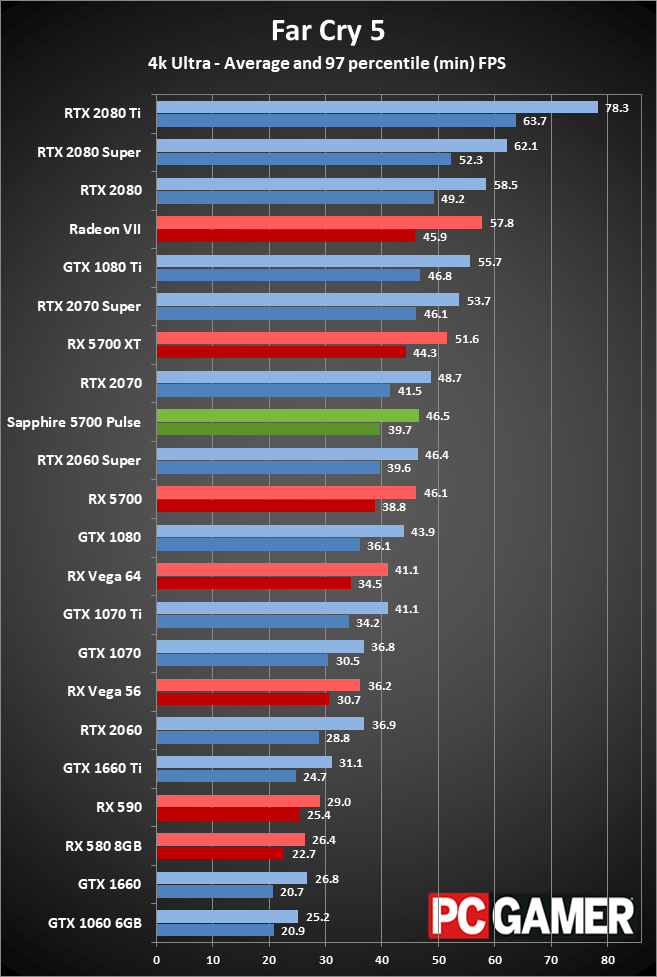
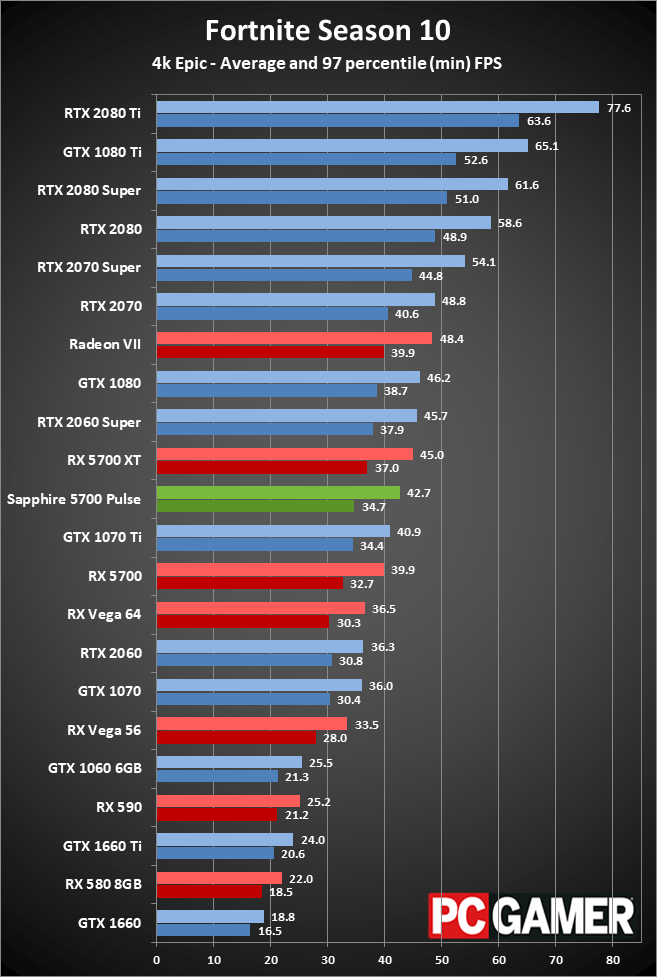
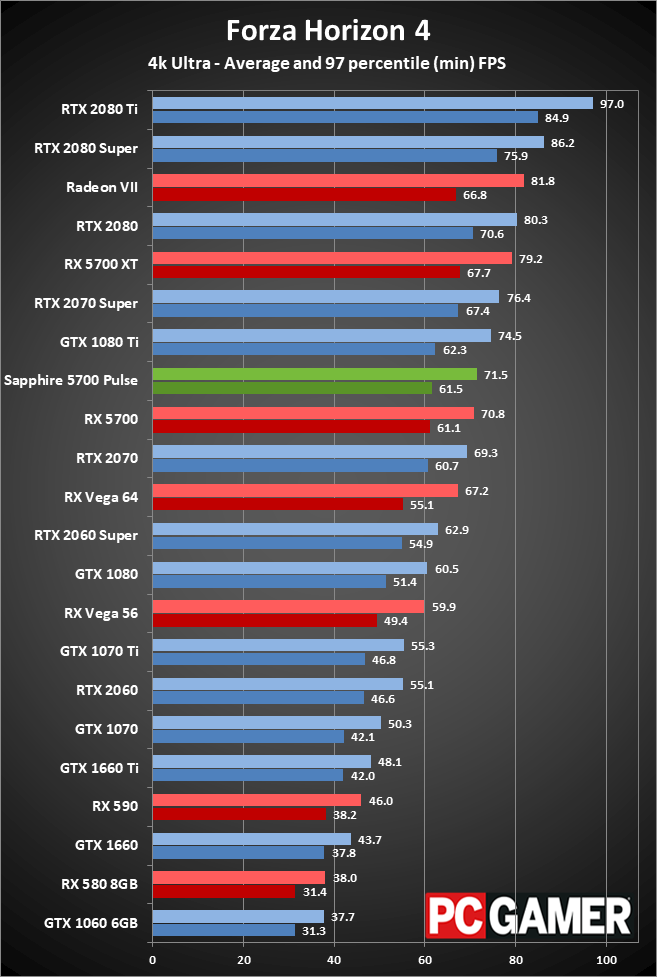
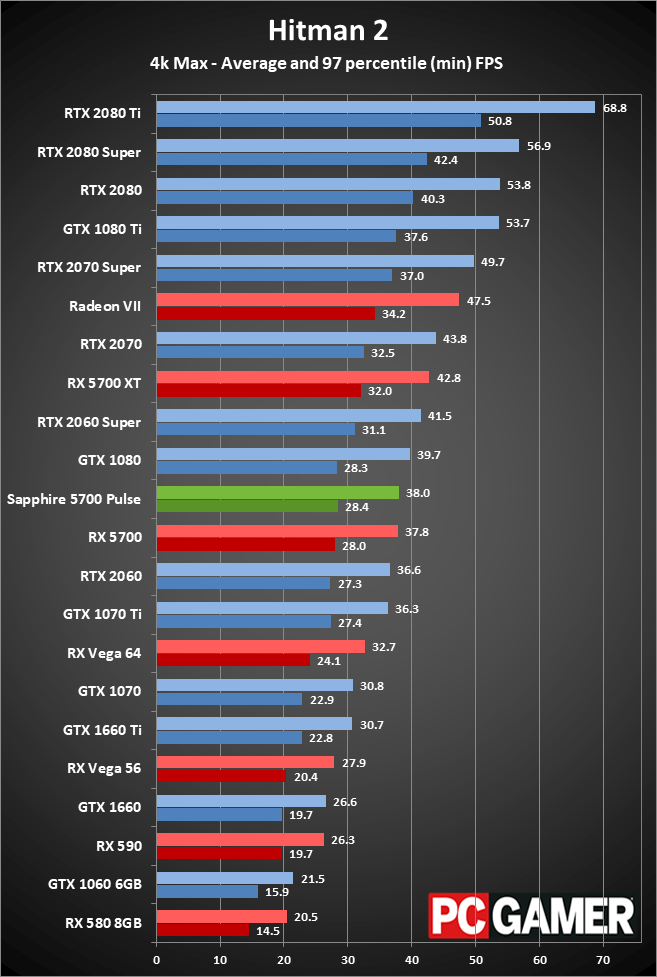
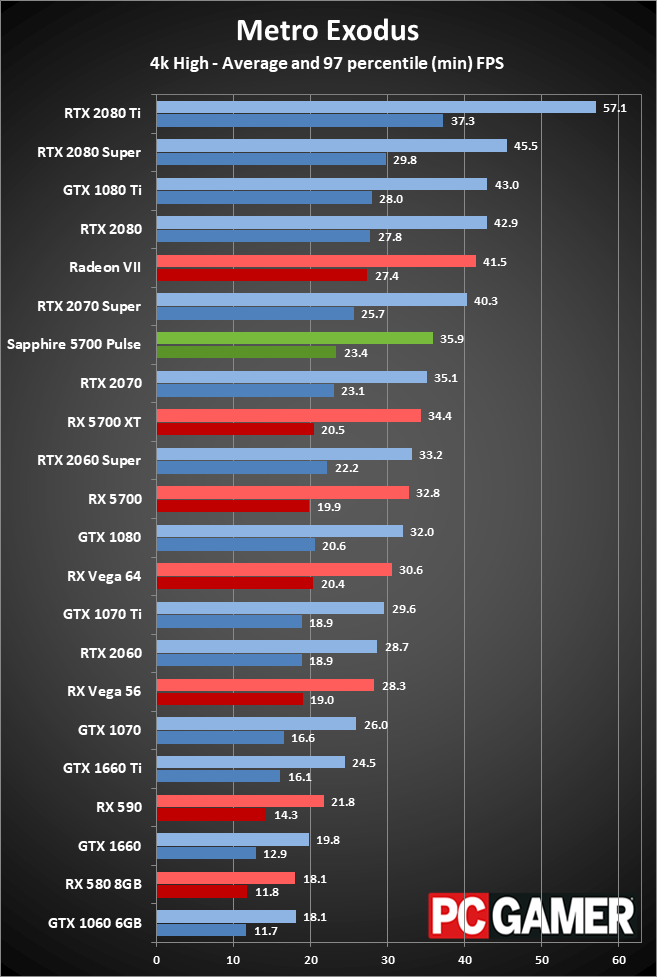
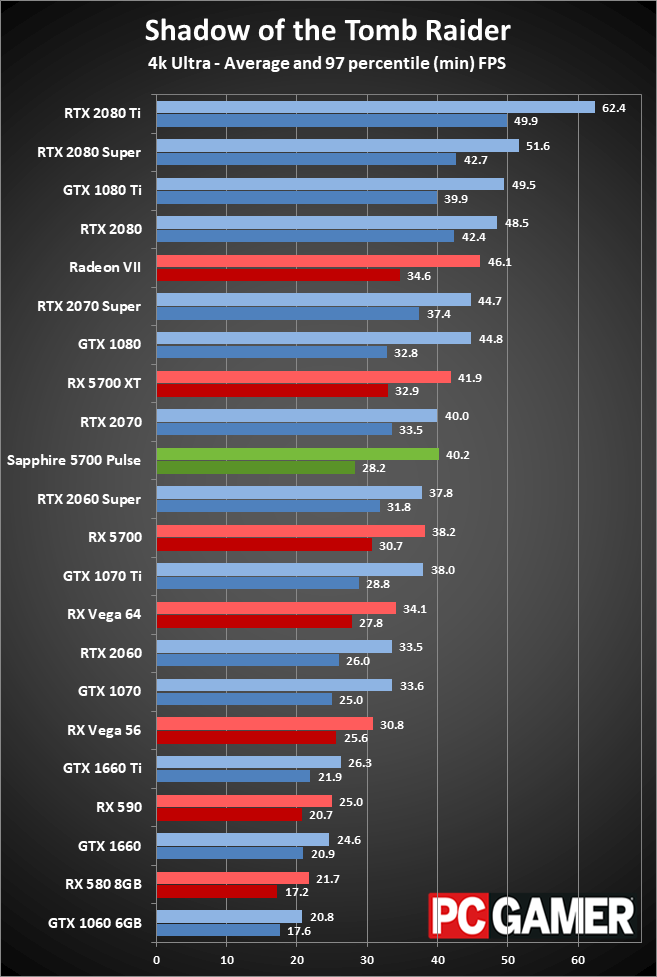
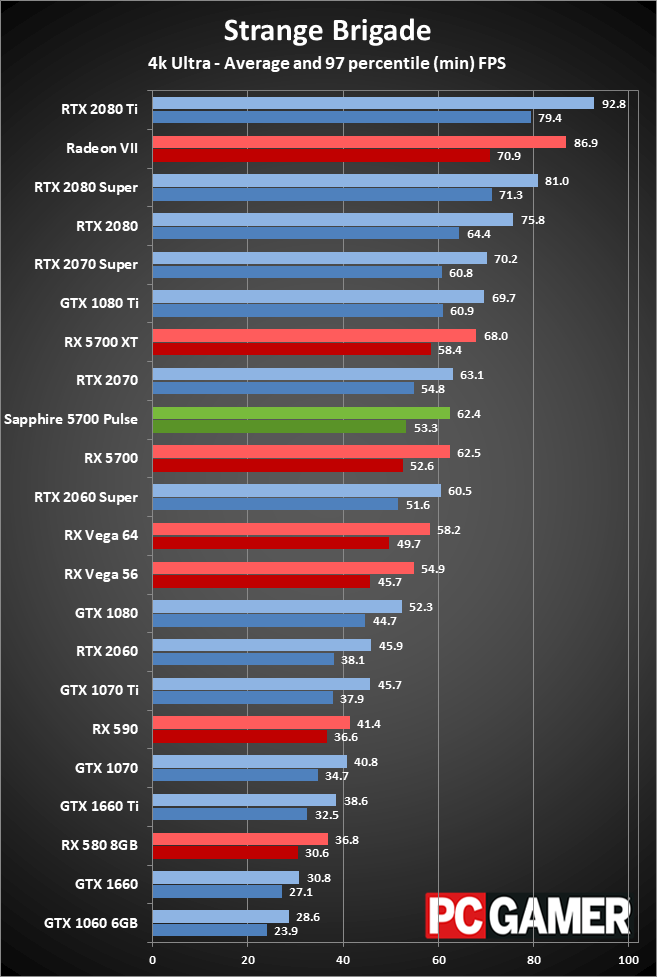

How the Sapphire 5700 Pulse does relative to its closest competition varies by game. Overall, it ends up being 1-4 percent faster than the reference RX 5700 on average. That's likely to the factory overclock, though drivers may have helped or hurt slightly in a few cases. At 1080p medium for example, Fortnite and Hitman 2 performance dropped a bit due to either drivers or game updates, with higher performance in Metro Exodus and Shadow of the Tomb Raider that mostly offsets any decreases. At higher settings and resolutions, most of the results have the Sapphire card tying or beating the reference card, which is what I'd expect, with Warhammer 2 being the one instance where there appears to have been a performance regression (again, likely due to drivers).
More important than the minor change in performance is the improvements in thermals and noise levels. Those two items are interlinked, so spinning the fans (or fan in the case of the blower) at a higher RPM will improve thermals at the cost of noise, and vice versa. To compare the GPUs, I'm running Borderlands 3 at 1440p ultra in my testbed. The testbed includes a liquid cooler for the CPU with two 140mm fans on the radiator that can definitely contribute to noise levels, so I'm going to measure at a range of 10cm from the GPU fans to focus on the GPU noise. (If you're wondering, from about one meter away the PC measures 35.5 dB(A).) These measurements are, of necessity, done with the side of the case removed so I can get close to the GPUs.
I let the game run for a while so that temperatures and fan speed would stabilize. After 15 minutes, the Sapphire 5700 Pulse reached a temperature of 72C on the GPU with an 80C junction temperature (on the VRMs), with the fans generating 44.7 dB(A)—that's at an RPM of around 1035, according to WattMan. Total system noise from 1m away remained virtually unchanged at 35.5 dB(A). By comparison, the reference RX 5700 with a single blower fan levels off at 73C (85C junction temperature), a noise level of 50.7 dB(A), and fan RPM of around 1850-1900. From one meter away, total system noise is also noticeably louder, reaching 39.8 dB(A).
The blower cooler isn't what I'd personally quantify as "loud," but it's certainly louder and I'd take the Sapphire Pulse over the reference design without a backward glance. And while I'm not reviewing the RX 5700 XT here, things are even worse with the higher performance GPU. Since it's basically the same cooler as the RX 5700 and has to dissipate more heat, the reference 5700 XT reaches 84C (100C junction) and 56.8 dB(A) (42.8 dB(A) from 1m), with a fan speed of 2100-2125 RPM. Unless you're planning a tight mini-ITX build where an open-air cooler doesn't really make sense, I recommend staying away from blowers as a general principle.
Looking at the bigger picture, AMD's RX 5700 continues to compete well against Nvidia's RTX 2060 and 2060 Super. It falls right between the two in terms of performance, but with a price closer to the less potent RTX 2060. That's of course without testing ray tracing performance, mostly because it's not possible to do so on any AMD GPU right now. Practically speaking, however, ray tracing likely isn't a major consideration for anyone looking at a $350 GPU. If you want the best possible ray tracing experience, you'll want to pony up for at least the RTX 2070 Super, and probably a 2080 Ti.
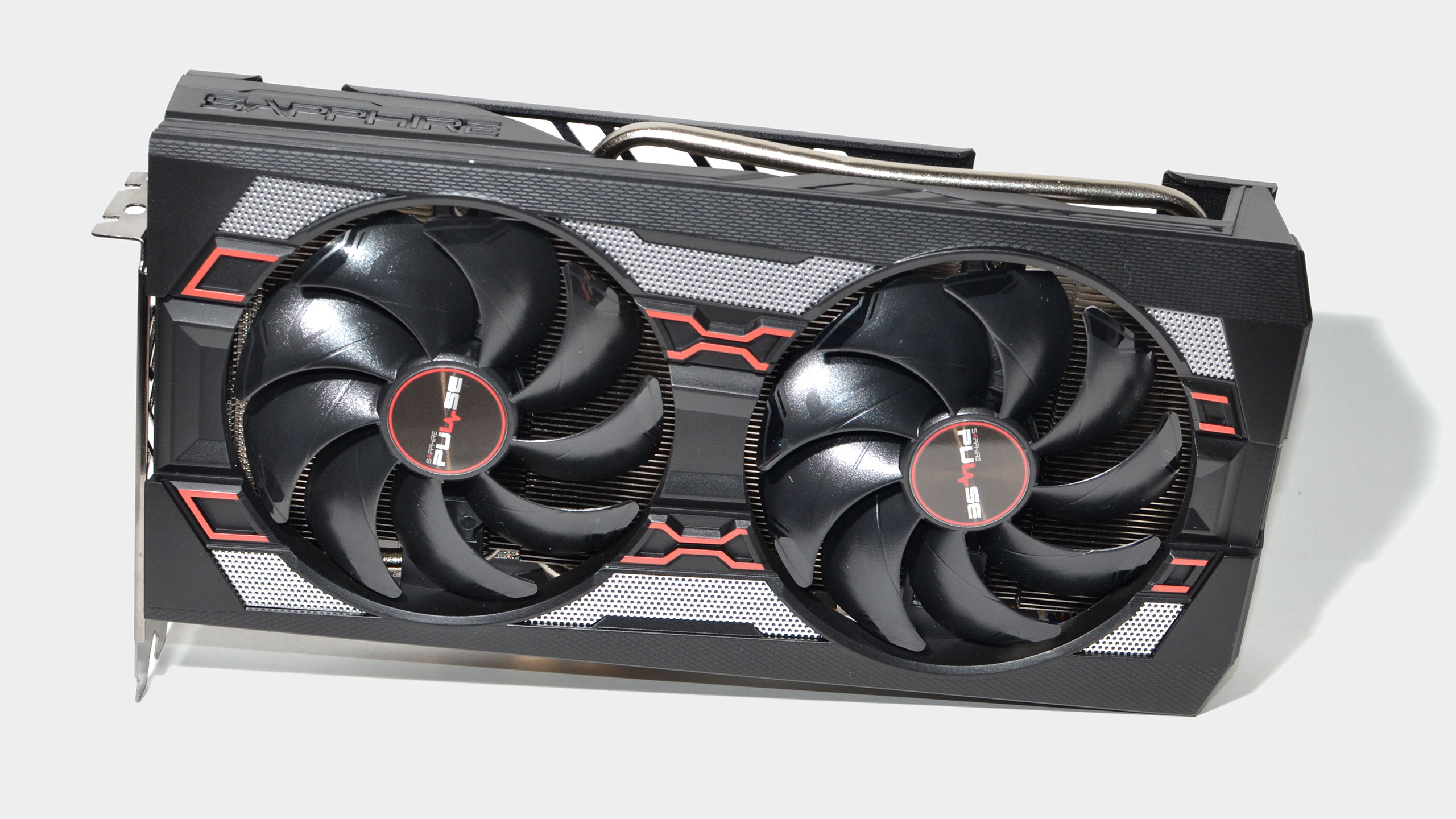
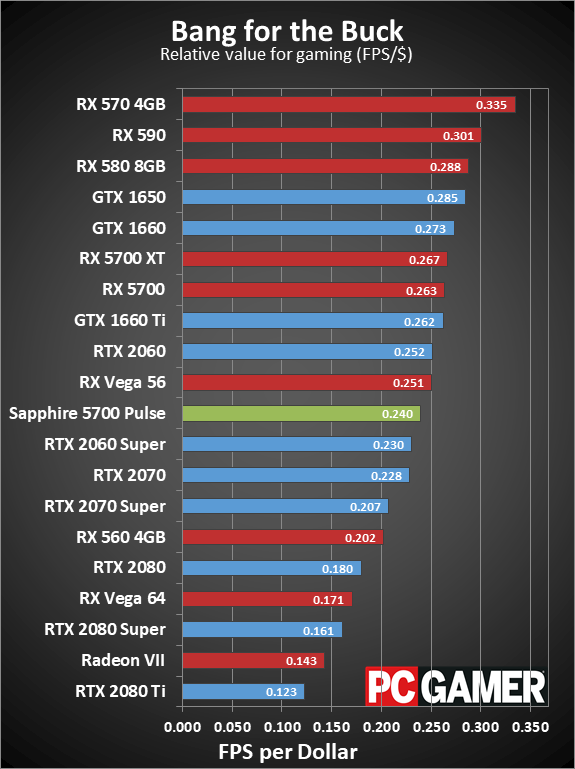
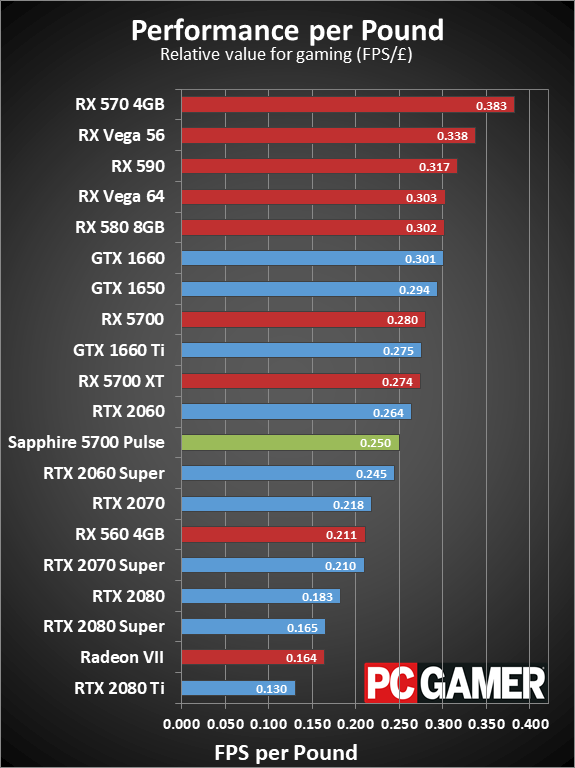
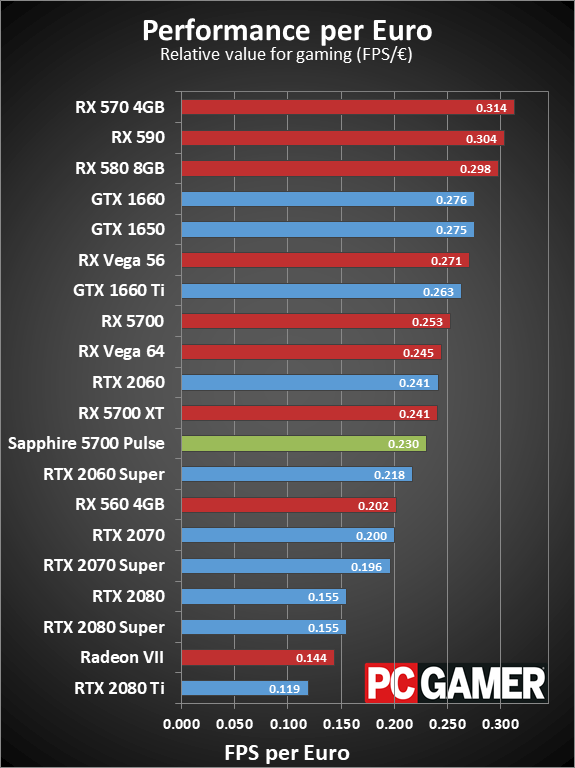
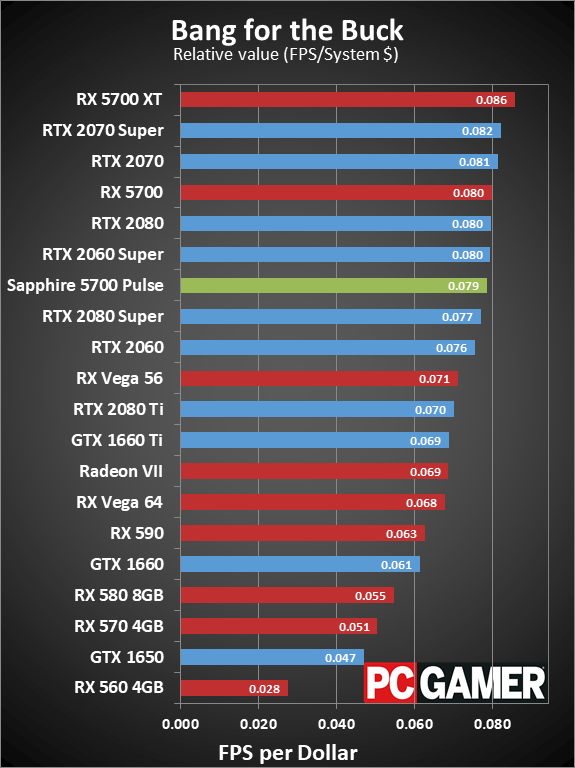
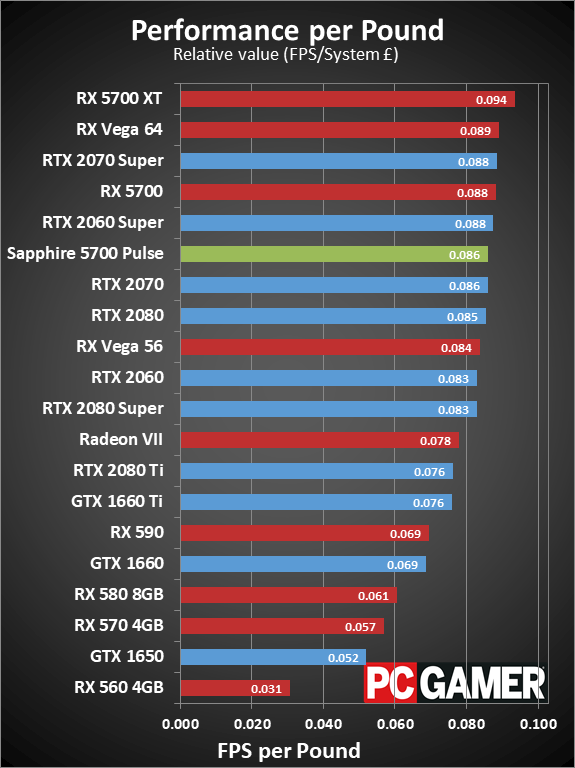
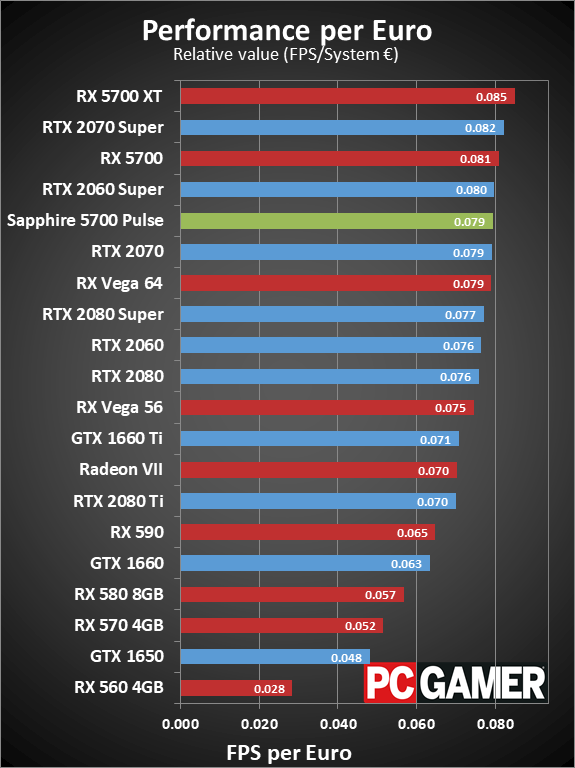
The above charts are current as of 10/01 using the best prices I could find for the various GPUs and other system components.
As a performance per dollar spent proposition, the Sapphire 5700 Pulse doesn't fare quite as well, but that's because it's difficult to factor in how much value there is in cooling and noise. The reference RX 5700 is only slightly slower but costs about $40 (or £40 or €40) less, making it the better buy from a pure monetary perspective. Bang for the buck still favors the RX 570/580/590 (and sometimes Vega), but all of those cards are basically on their way out now. There's excess inventory still waiting to be sold, but prices on most of those cards are increasing now rather than dropping.
Looking at total system cost (using a mainstream PC build priced around $700, not including the graphics card), the RX 5700 XT tops the charts, but the RX 5700, RTX 2070 Super, RX 5700, and RTX 2060 Super are all in the mix, depending on your location. Even high-end and extreme graphics cards can be 'reasonable' if you're looking at building a new gaming PC, though of course you don't actually need to play every game at 1440p ultra to have an enjoyable gaming experience. For many PC gamers, cards in the $250-$350 range end up being the best overall picks, and the Sapphire 5700 Pulse is certainly in that range.
Sapphire RX 5700 Pulse: clearly better than the reference card
Buying a reference graphics card from AMD or Nvidia is usually a safe bet, but like most reference designs, AMD's RX 5700 series isn't the best of breed. Sapphire is an exclusively AMD brand for graphics cards, and once again it delivers a card that runs cooler and quieter, without a massive jump in pricing. Right now prices are slightly higher than the reference blower cards, but I think that has more to do with retailers trying to get rid of the now-discontinued reference designs than anything, and the reason the reference design is already discontinued has a lot to do with the cooling and temperatures.
Other sites have gone into more detail on the subject, but in short, the junction temperature on the VRMs tends to get quite hot, particularly on the 5700 XT models. Now that superior designs are available from add-in board partners like ASRock, Asus, Gigabyte, MSI, Sapphire, XFX, and more, AMD is quietly letting its inferior blower cooler fade away. It's not the only GPU that's quietly being phased out, though. The Radeon VII was never a great option for gaming, and I have to wonder how many of those cards ended up in the hands of gamers. AMD said it would have sufficient cards available to "meet demand from gamers," but when there's effectively no demand that means even a few thousand cards would be enough.
Part of the reason the Radeon VII isn't interesting is because the RX 5700 cards are so much better. Sure, they have less VRAM and memory bandwidth, and theoretically less performance, but across my suite of gaming benchmarks, the Radeon VII isn't substantially faster than the far more efficient RX 5700 / RX 5700 XT. If you're not interested in buying an Nvidia graphics card, for now AMD remains the only viable alternative—though that might change next year with the upcoming Intel Xe. Which brings me back to Sapphire.
The Sapphire RX 5700 Pulse isn't substantially faster than other RX 5700 cards, but if you're in the market for an RX 5700, it definitely belongs on your short list. Thanks to the heatsink and dual fans, noise levels and temperatures are both much better than on the reference blower cards, which are rebranded and sold by all of AMD's partners. I'm not saying you absolutely shouldn't buy one of the reference cards, but if you didn't jump at the option two months ago when the RX 5700 first came out, there's little reason to do so now. Instead, pick up a superior card like the Sapphire RX 5700 Pulse and your ears will undoubtedly thank you.
Sapphire's RX 5700 Pulse runs cooler and quieter than AMD's reference design, delivering good performance in a better package.
Jarred's love of computers dates back to the dark ages when his dad brought home a DOS 2.3 PC and he left his C-64 behind. He eventually built his first custom PC in 1990 with a 286 12MHz, only to discover it was already woefully outdated when Wing Commander was released a few months later. He holds a BS in Computer Science from Brigham Young University and has been working as a tech journalist since 2004, writing for AnandTech, Maximum PC, and PC Gamer. From the first S3 Virge '3D decelerators' to today's GPUs, Jarred keeps up with all the latest graphics trends and is the one to ask about game performance.
